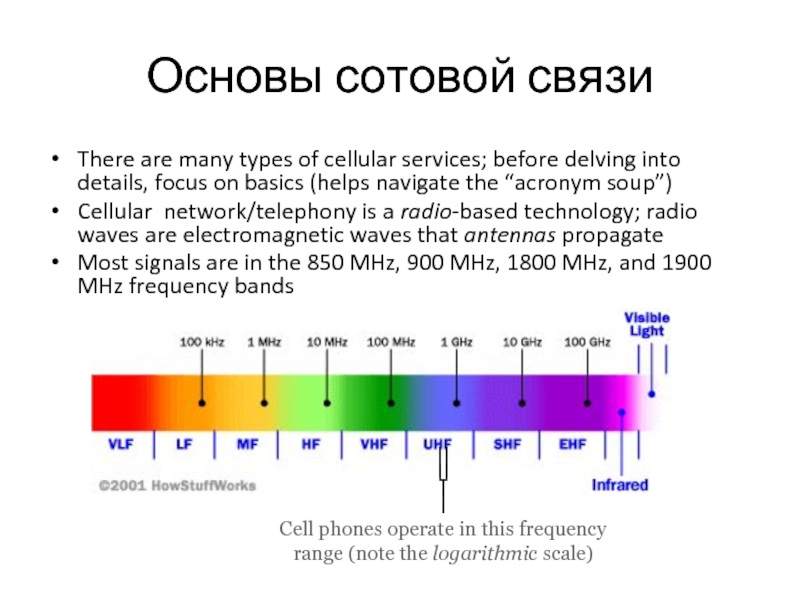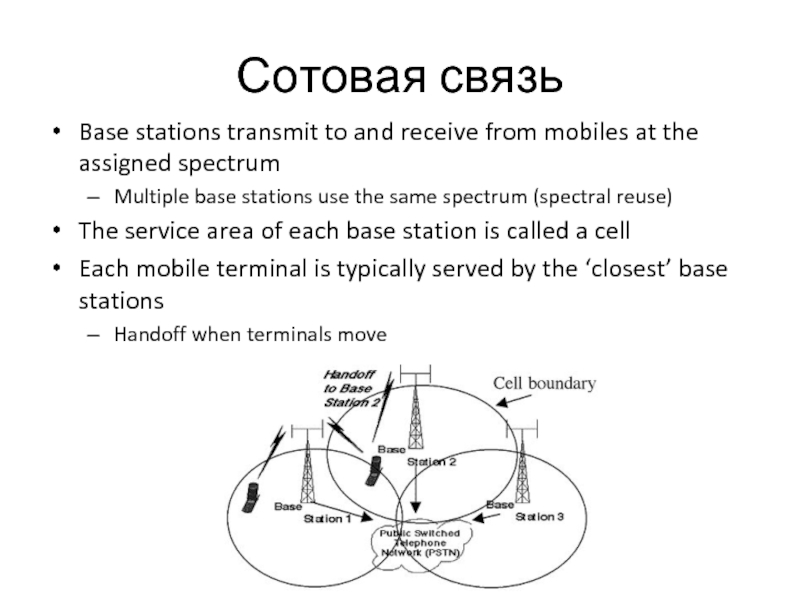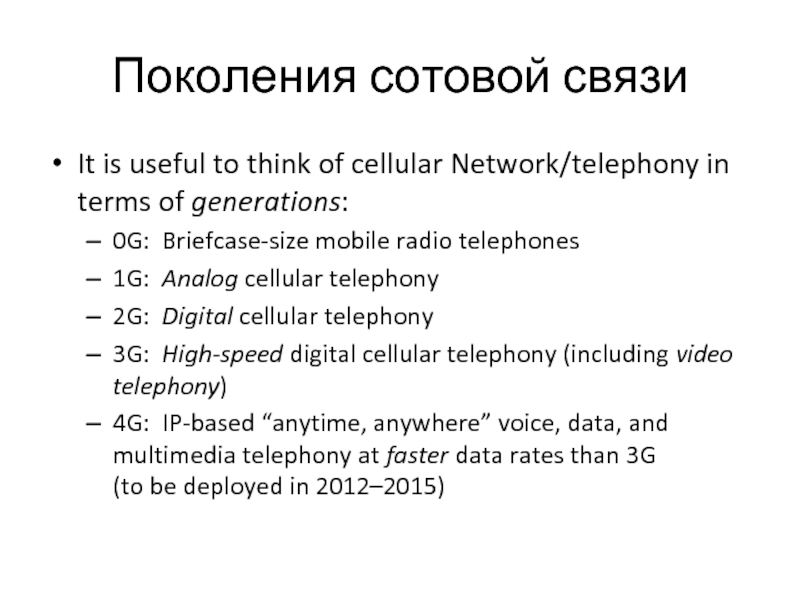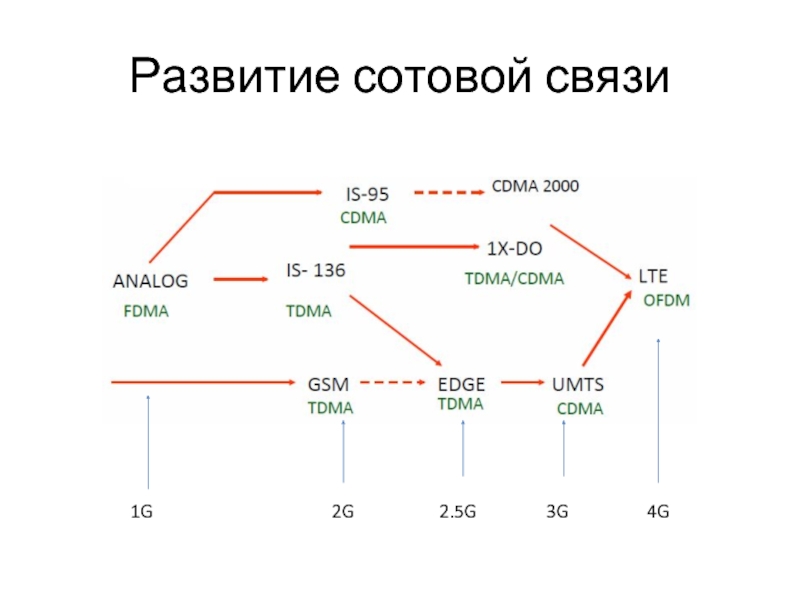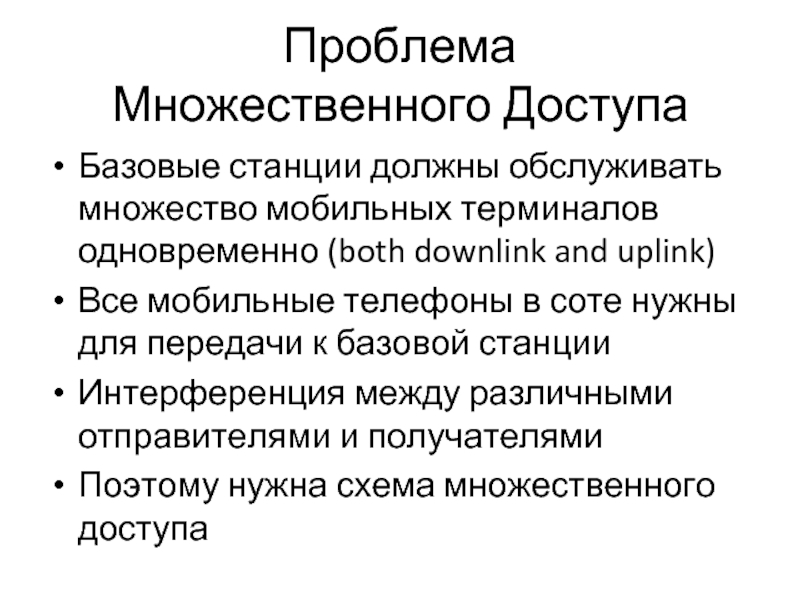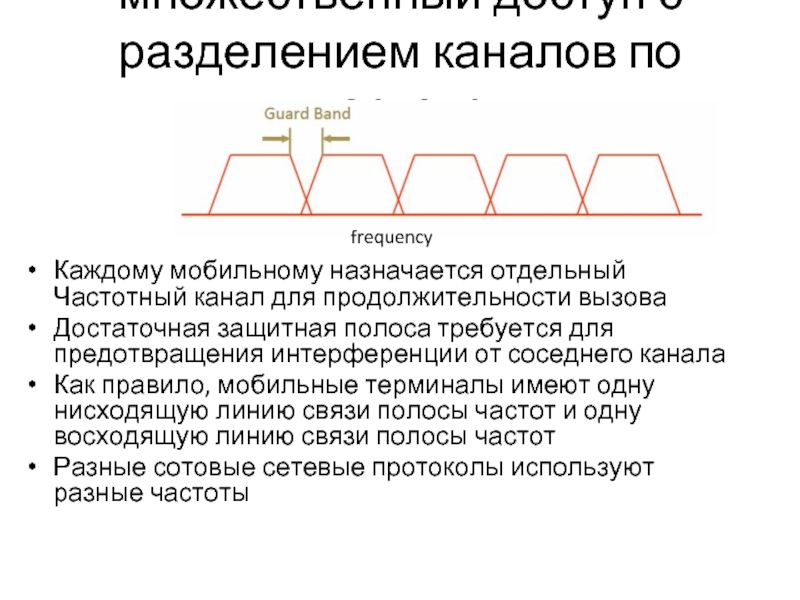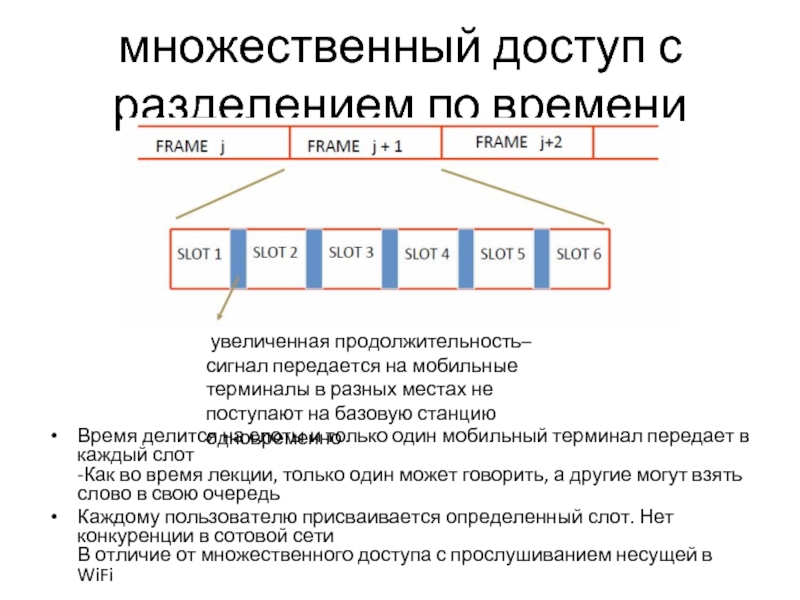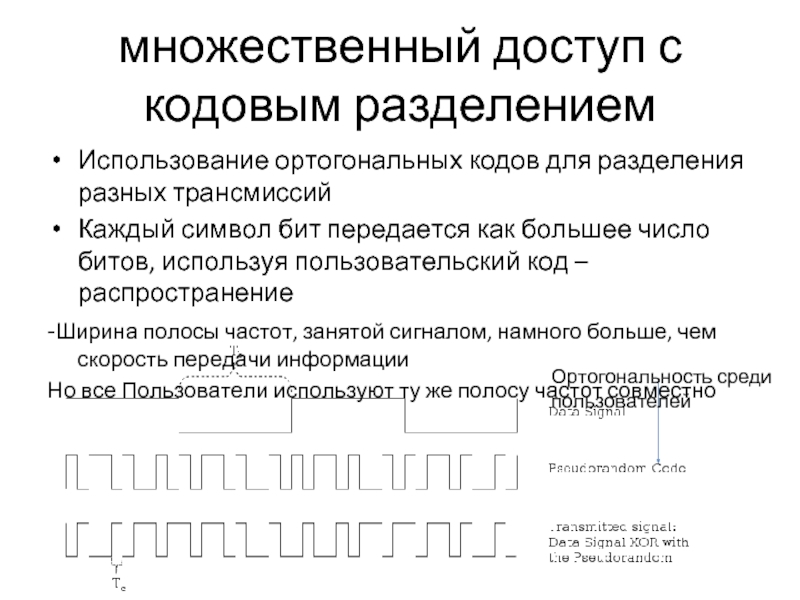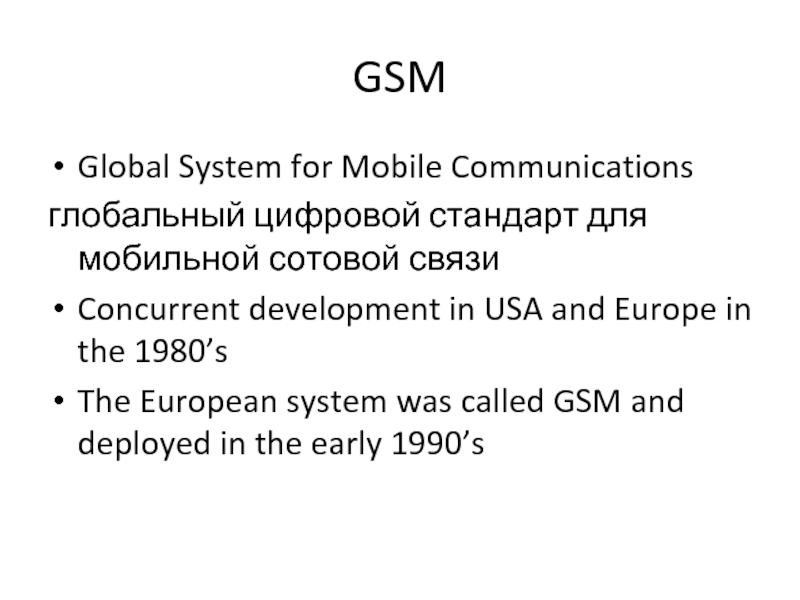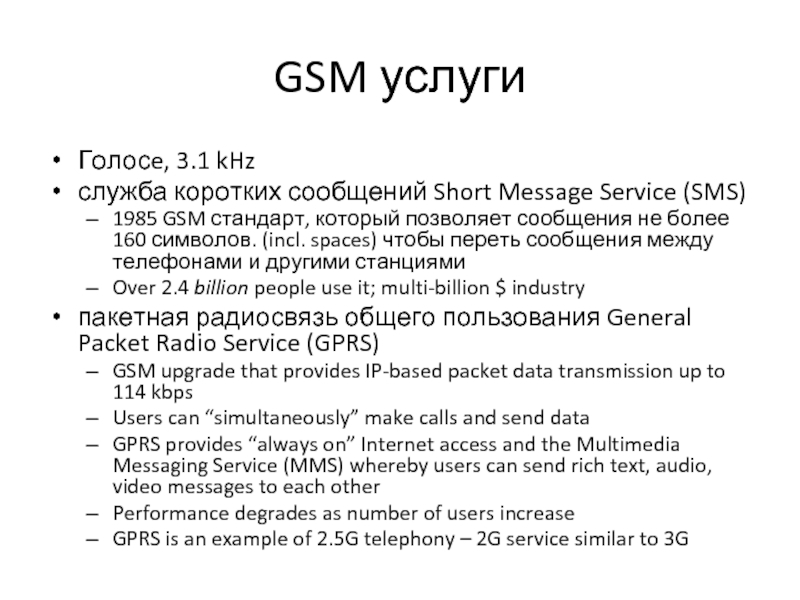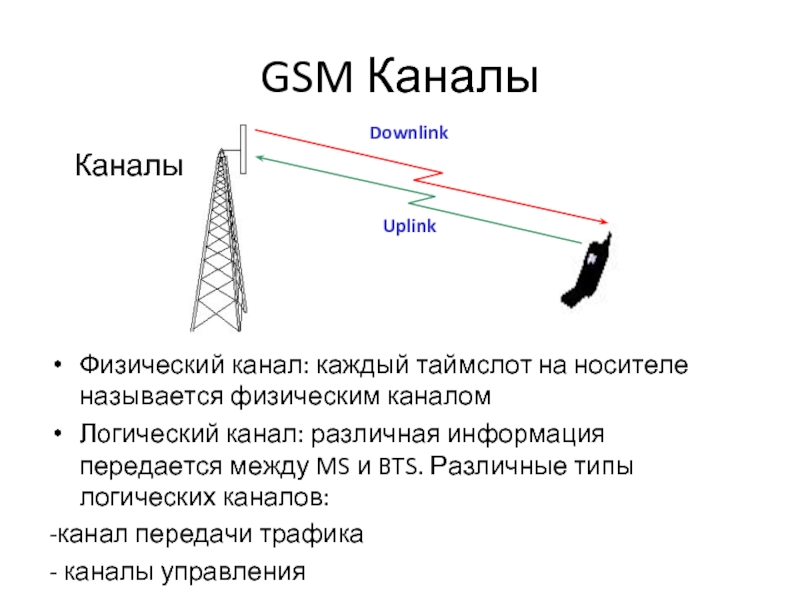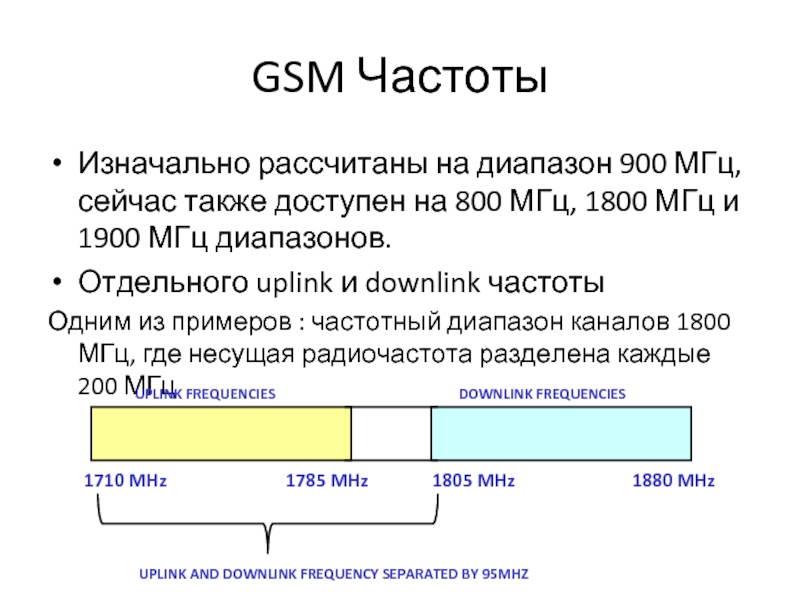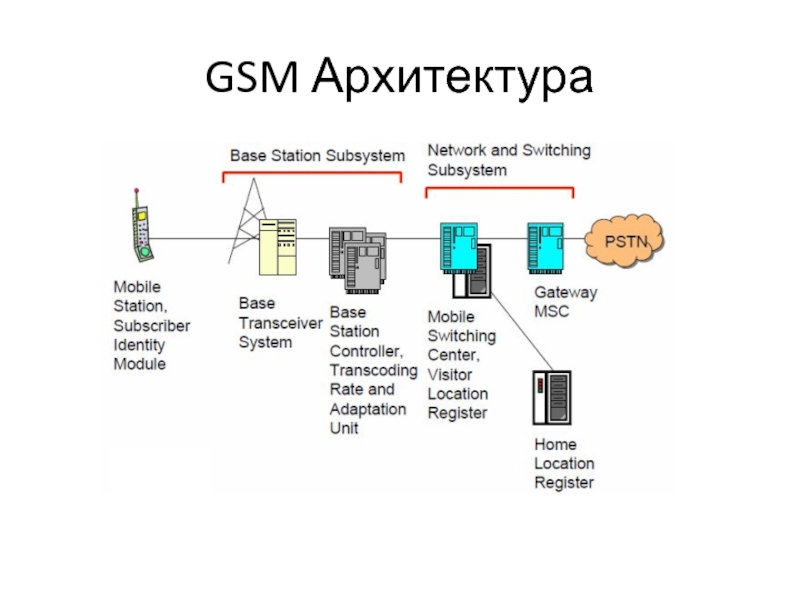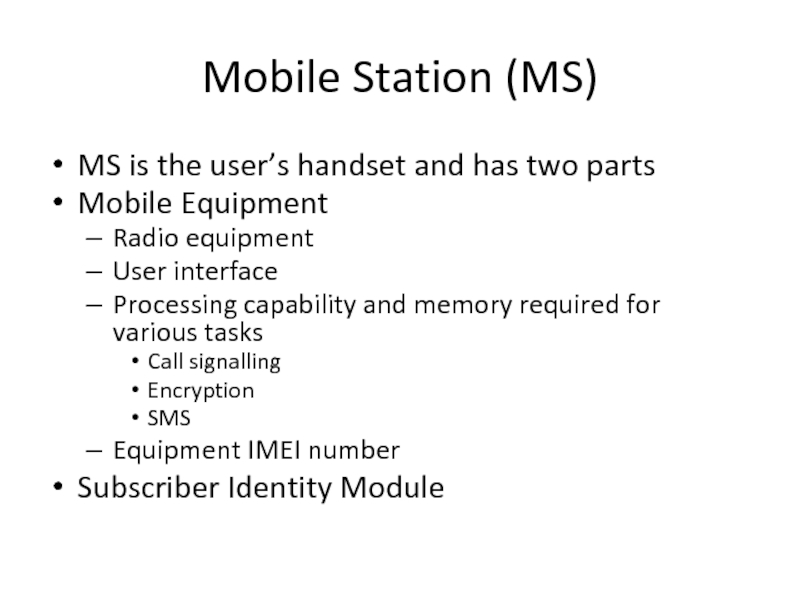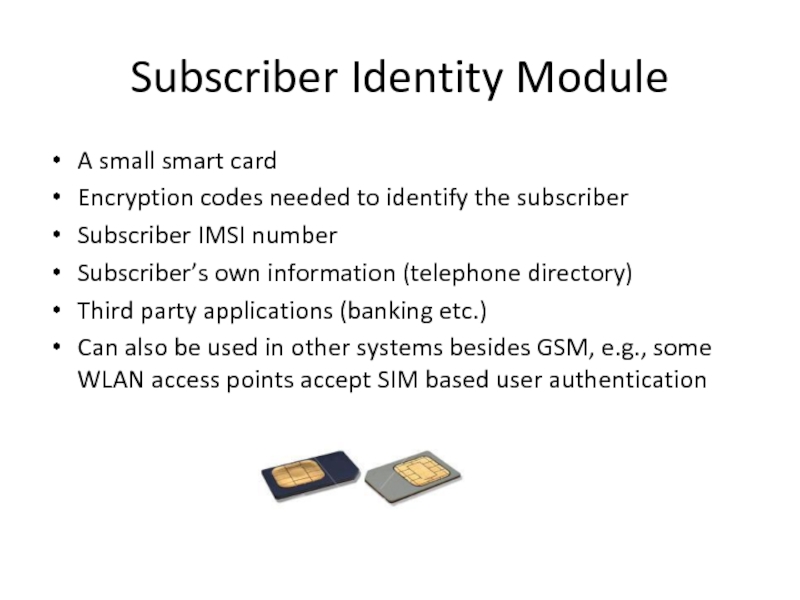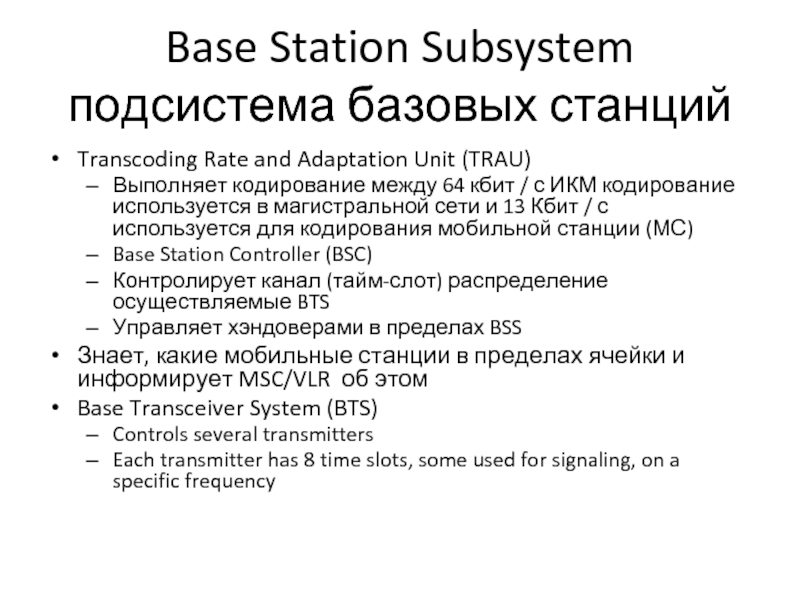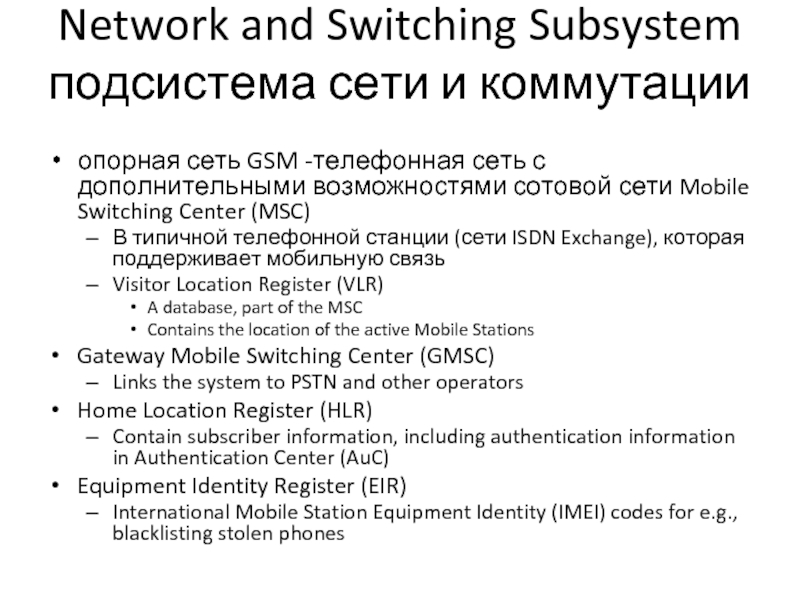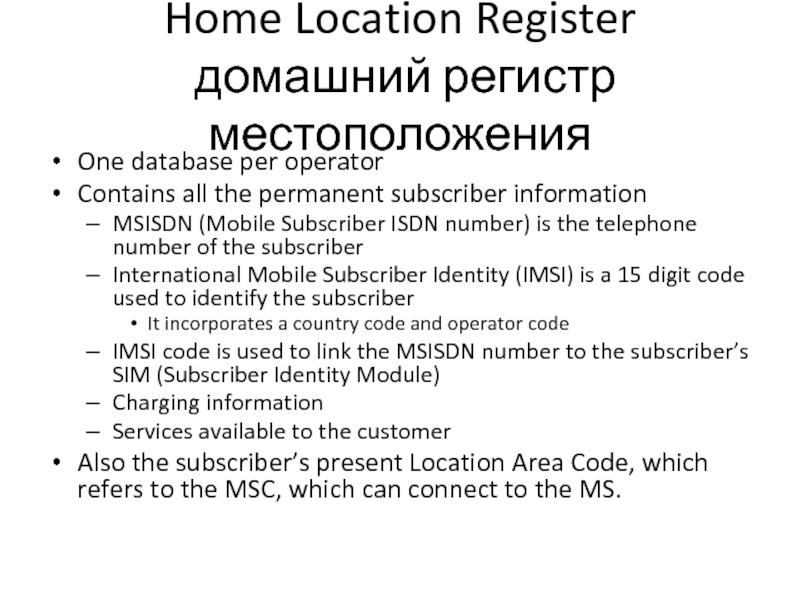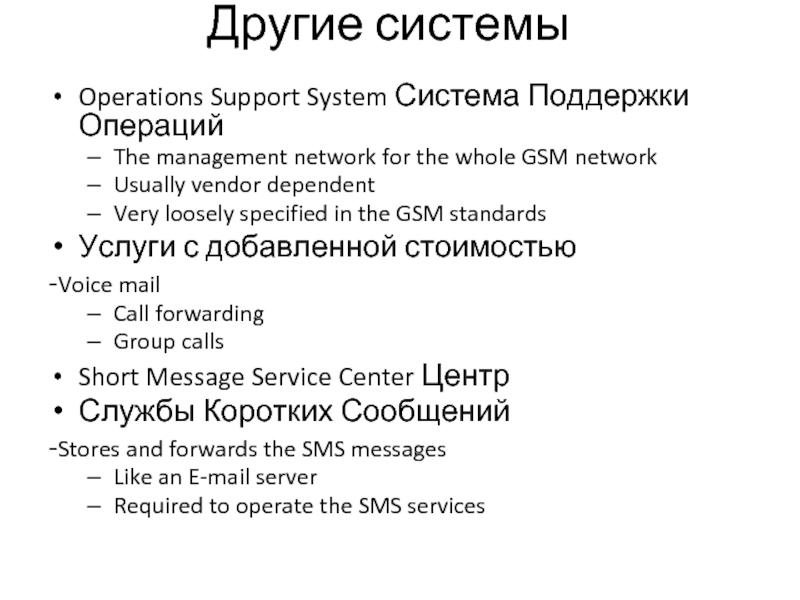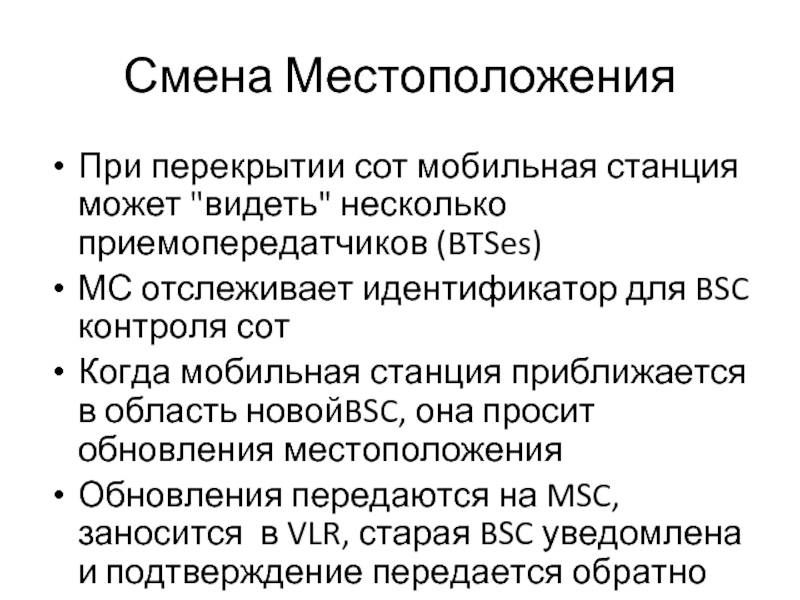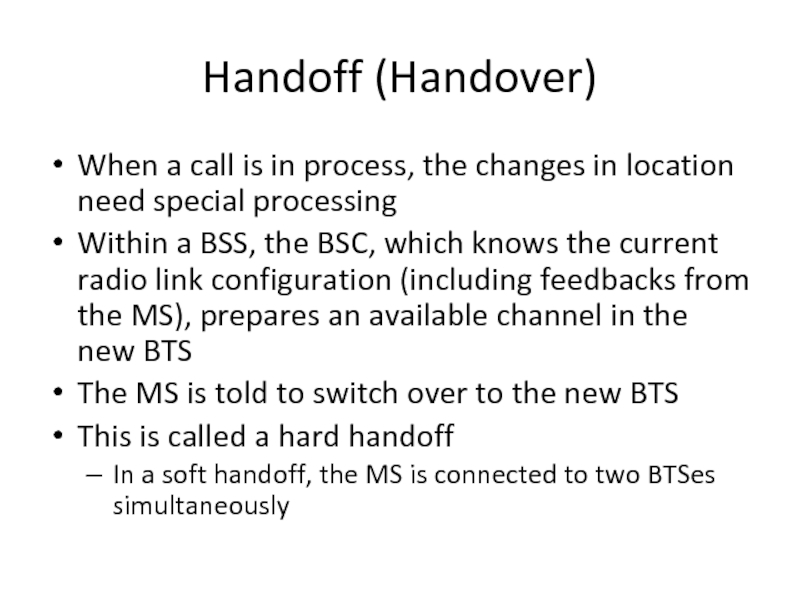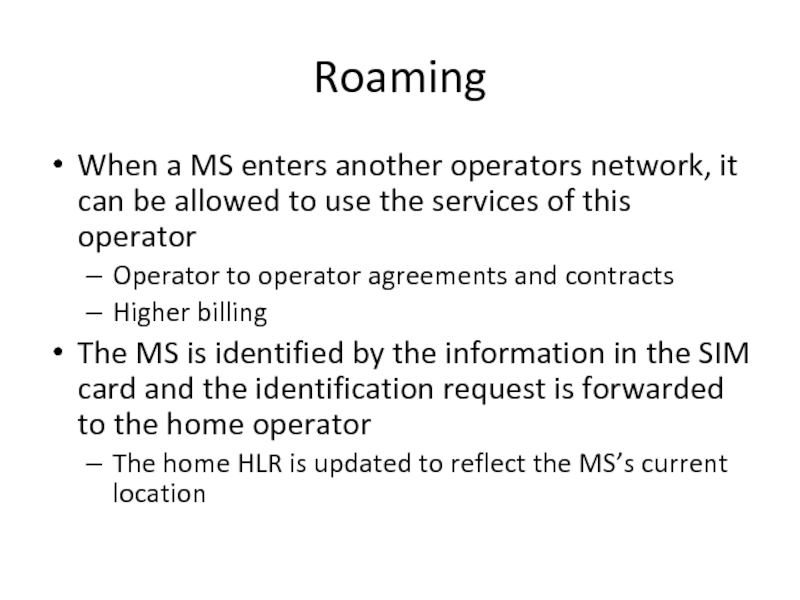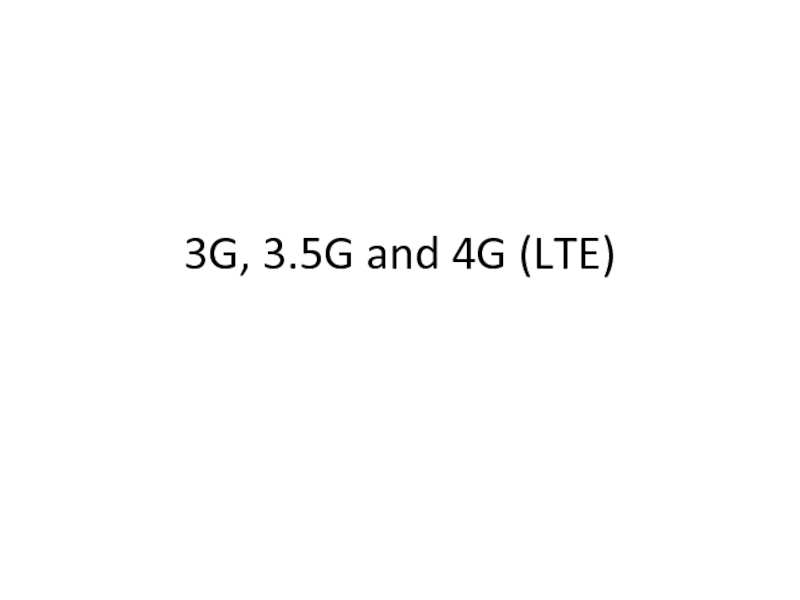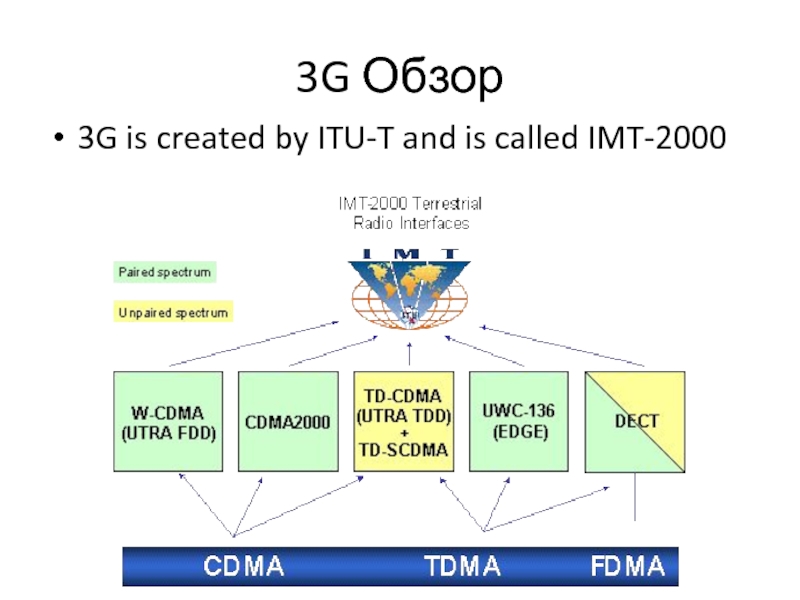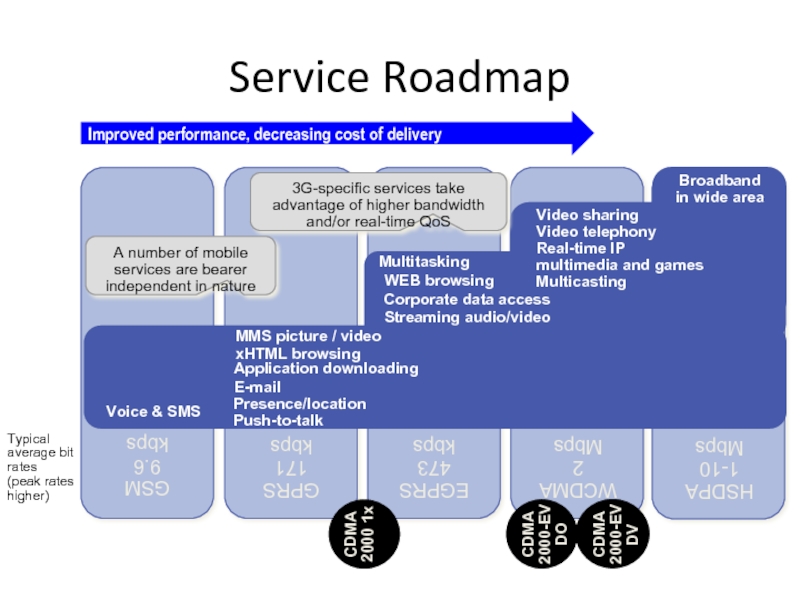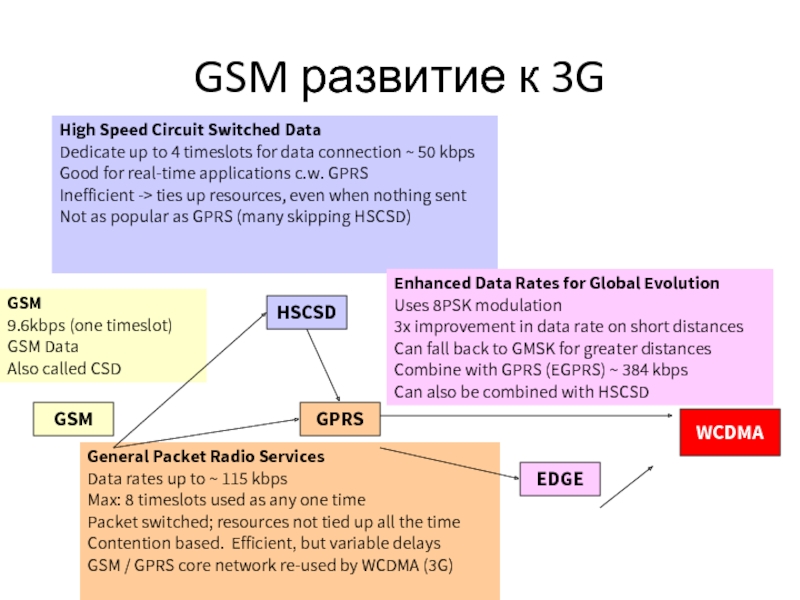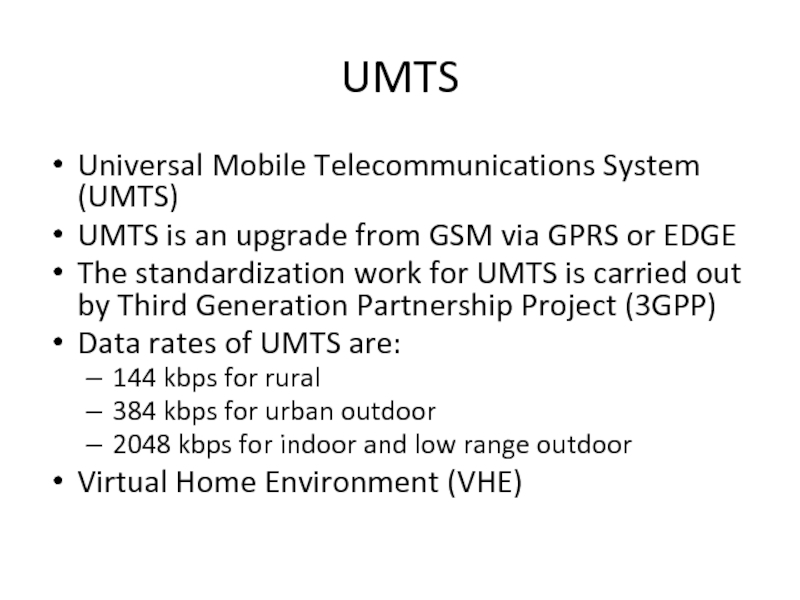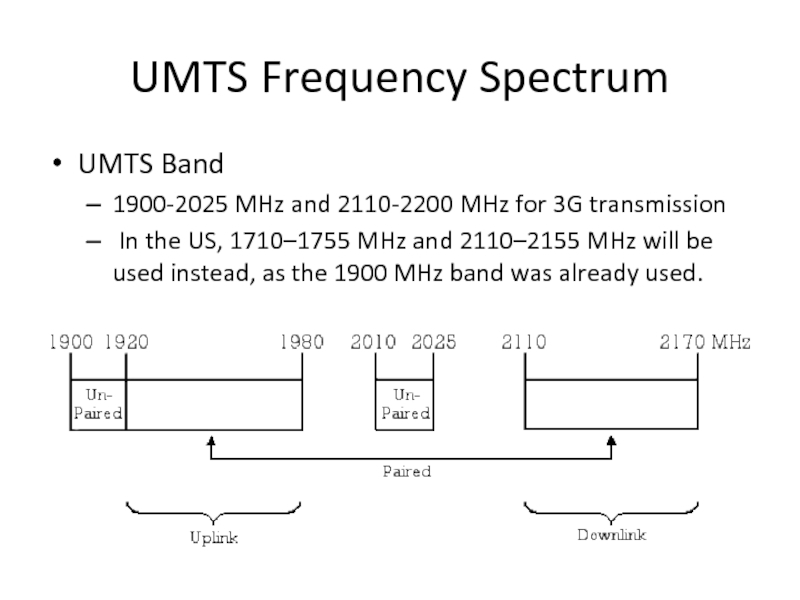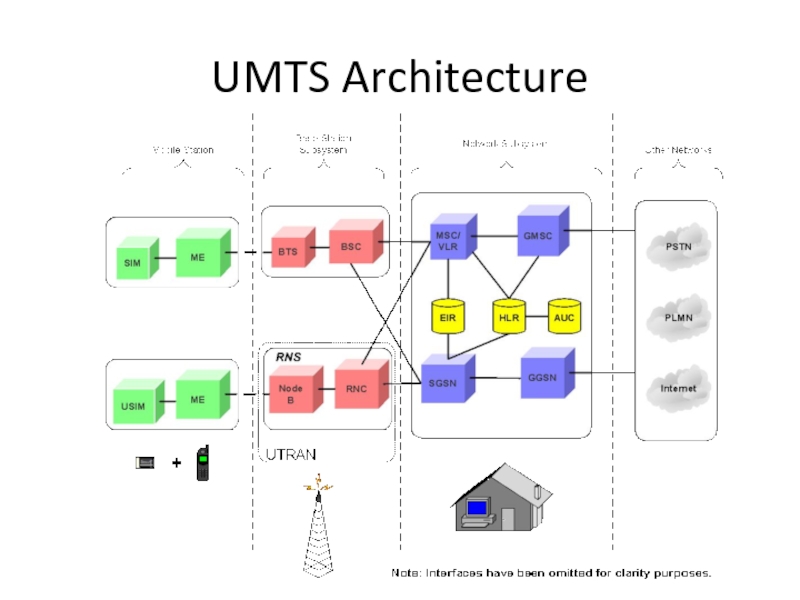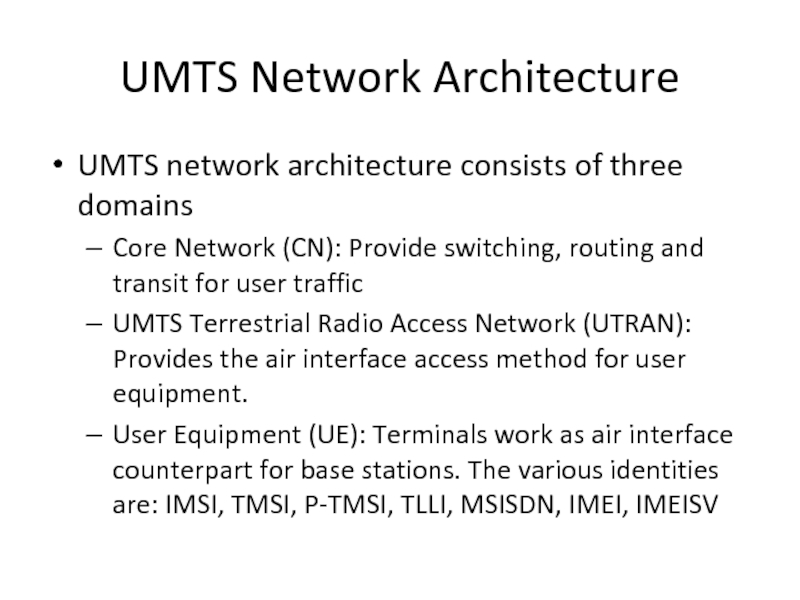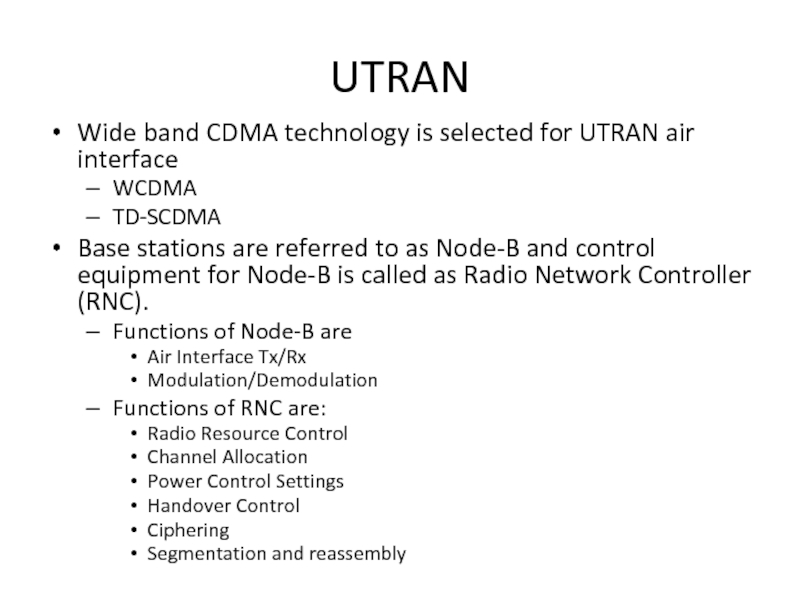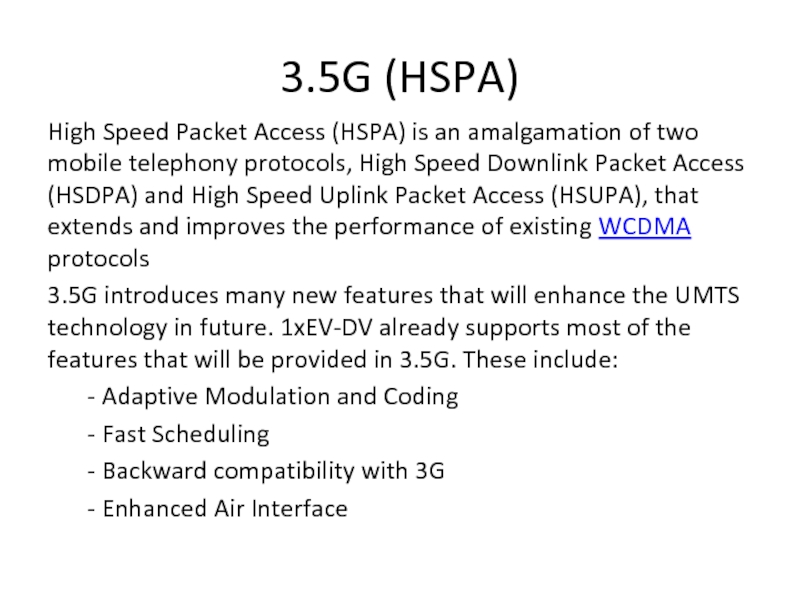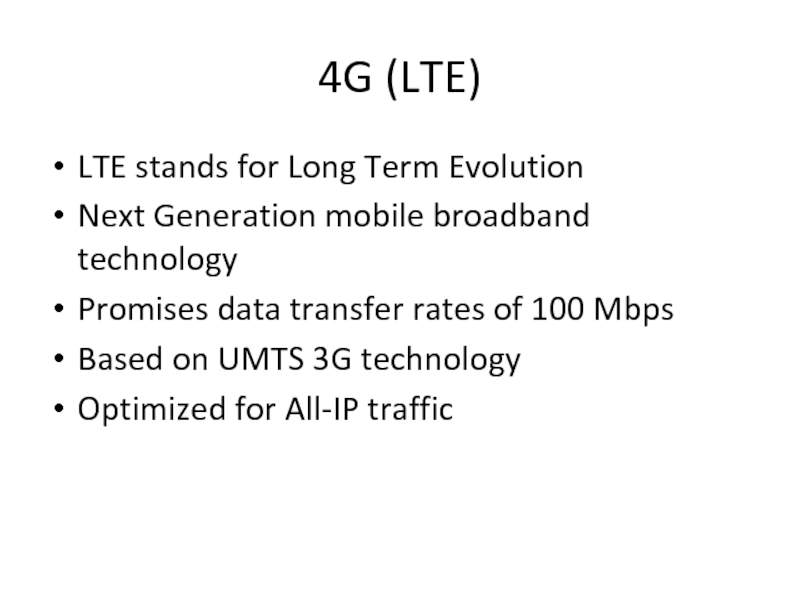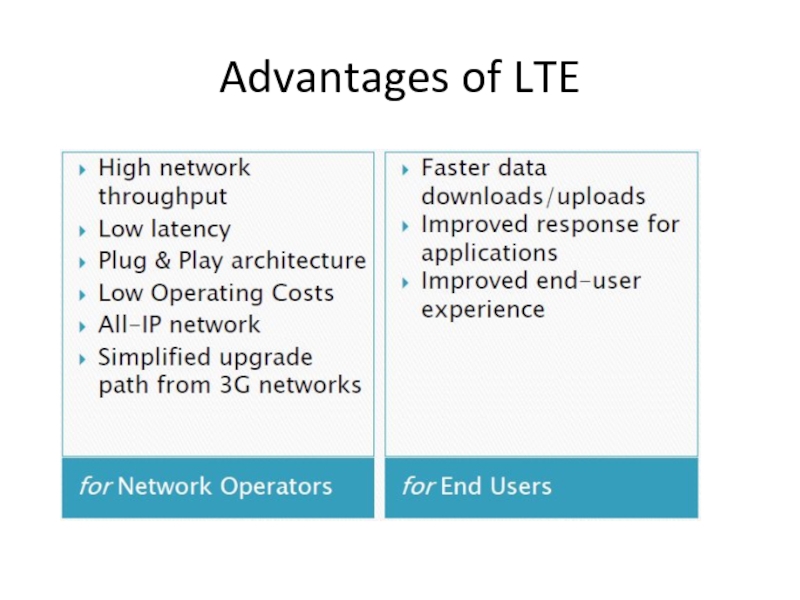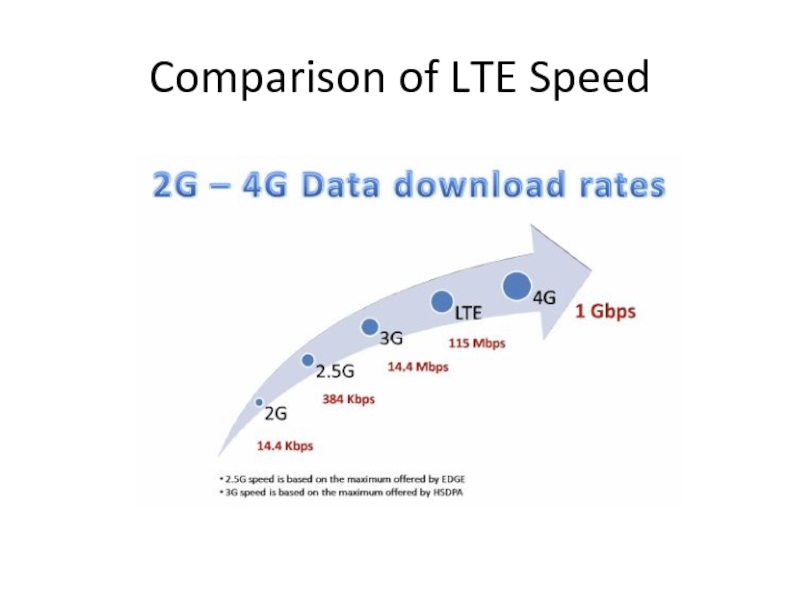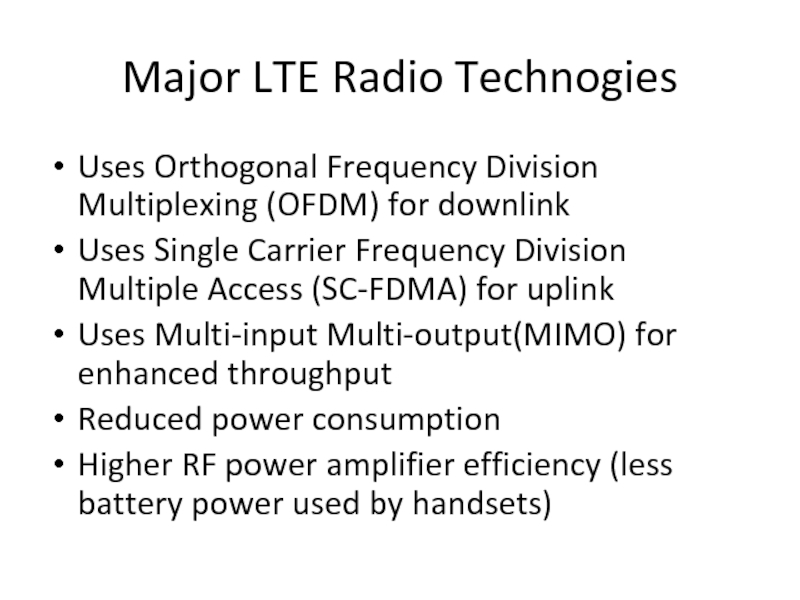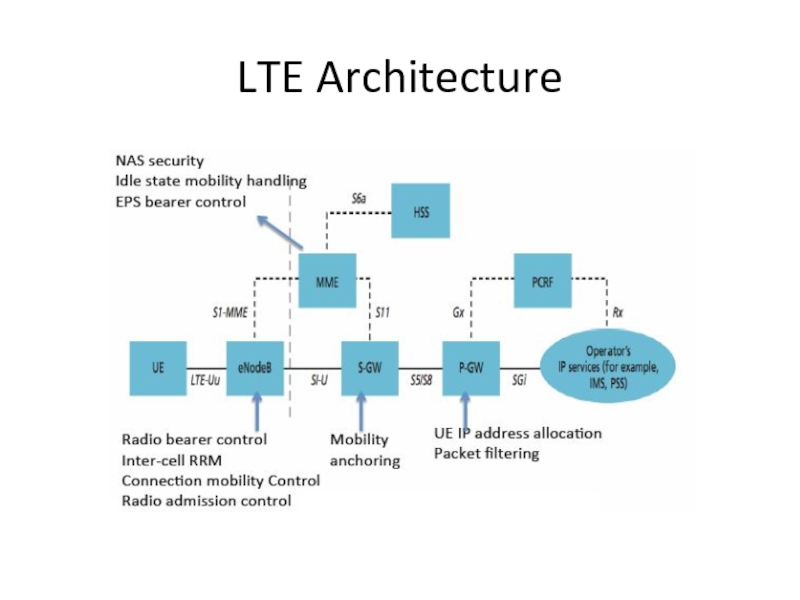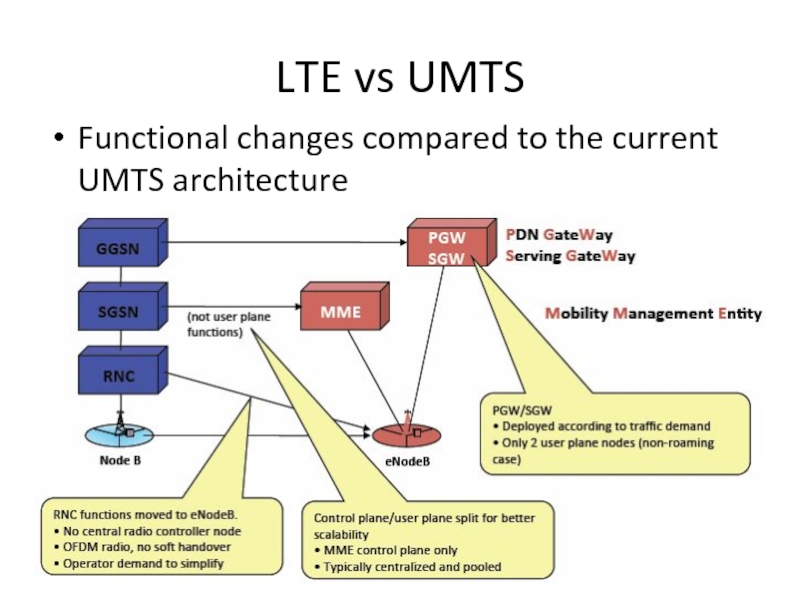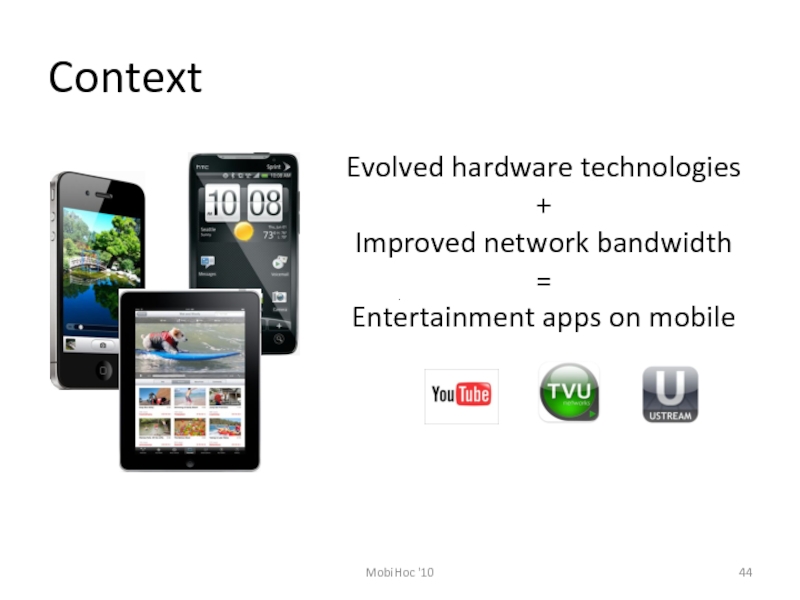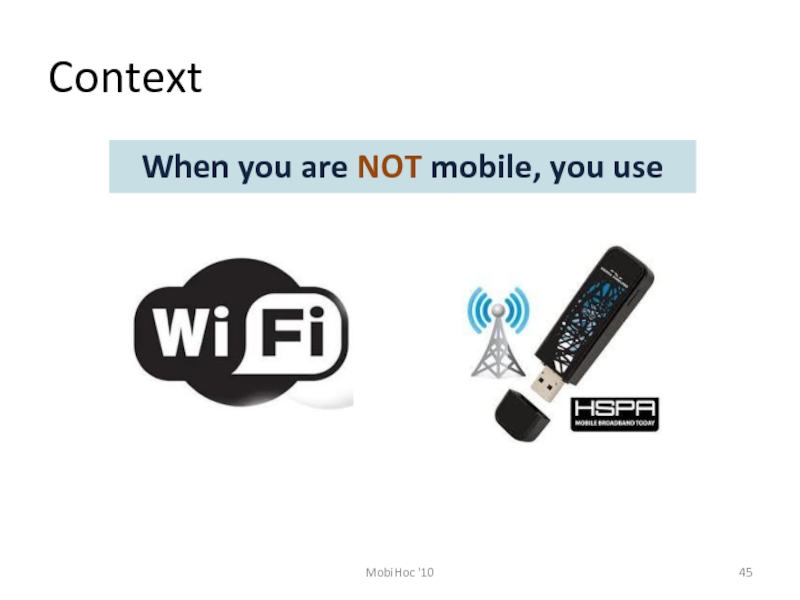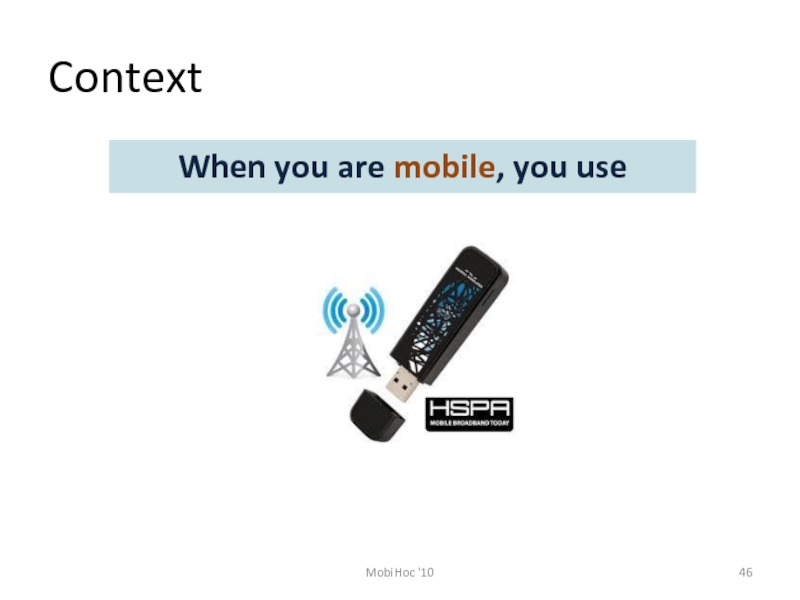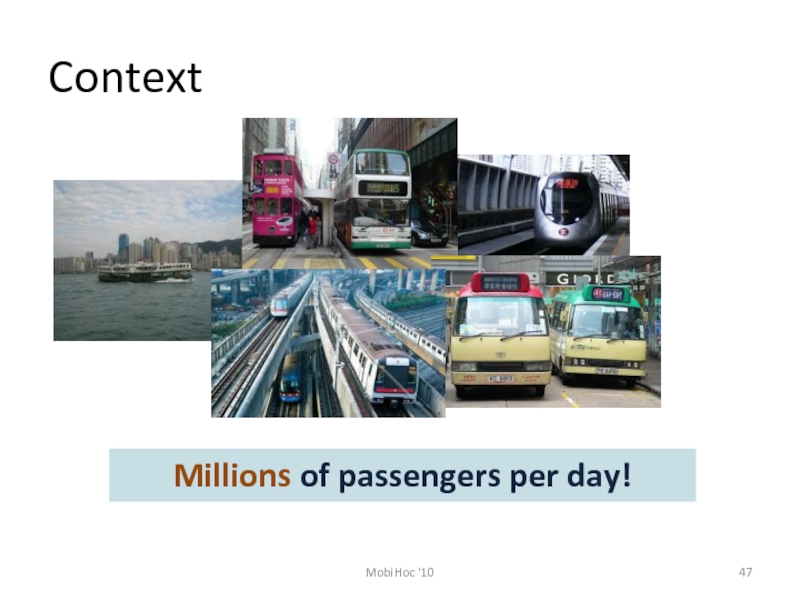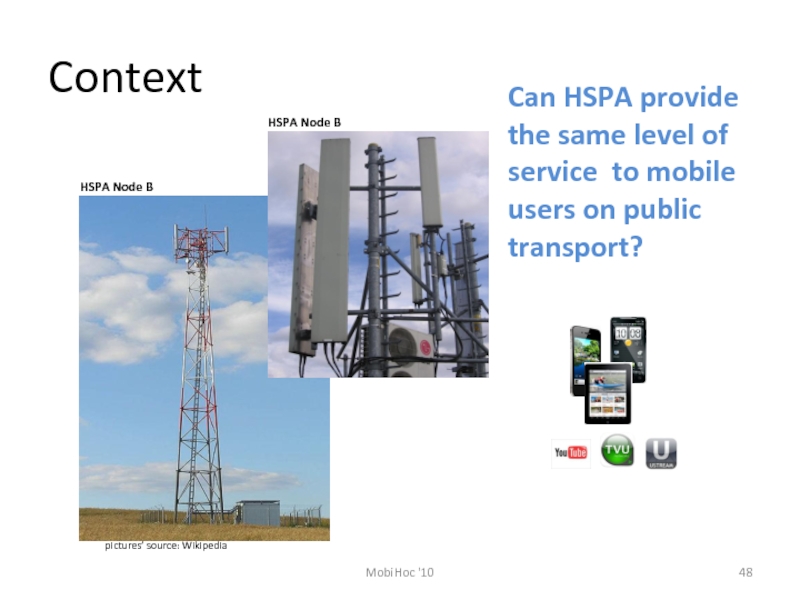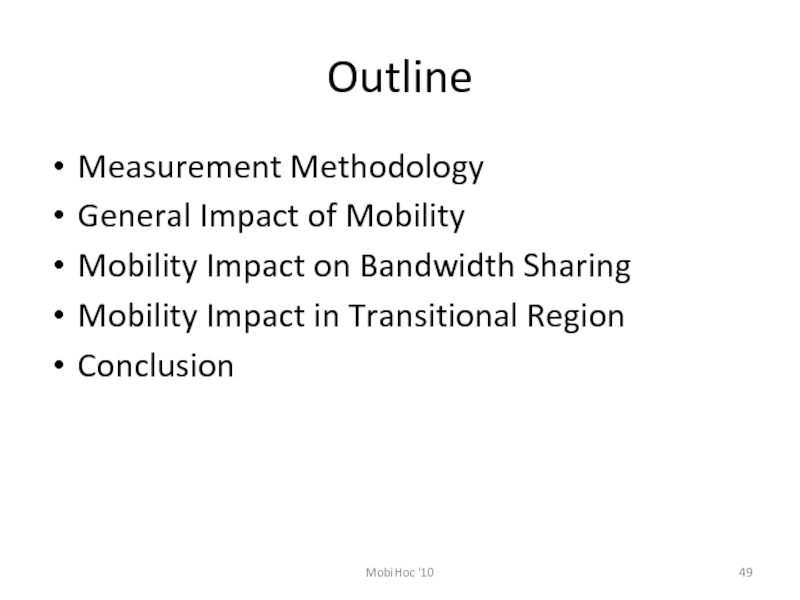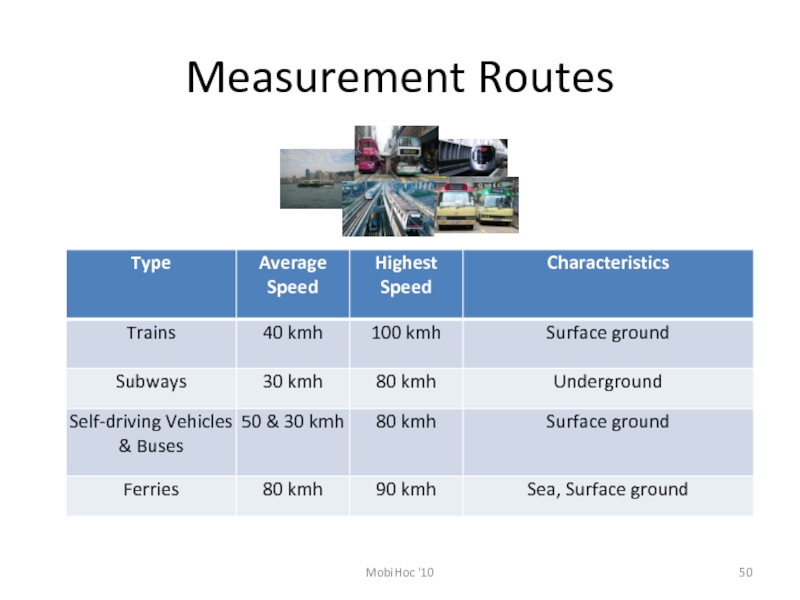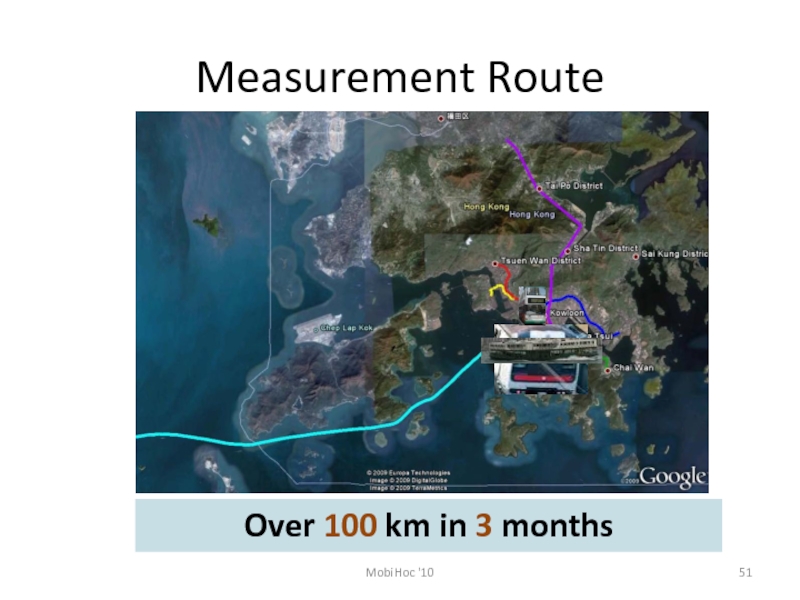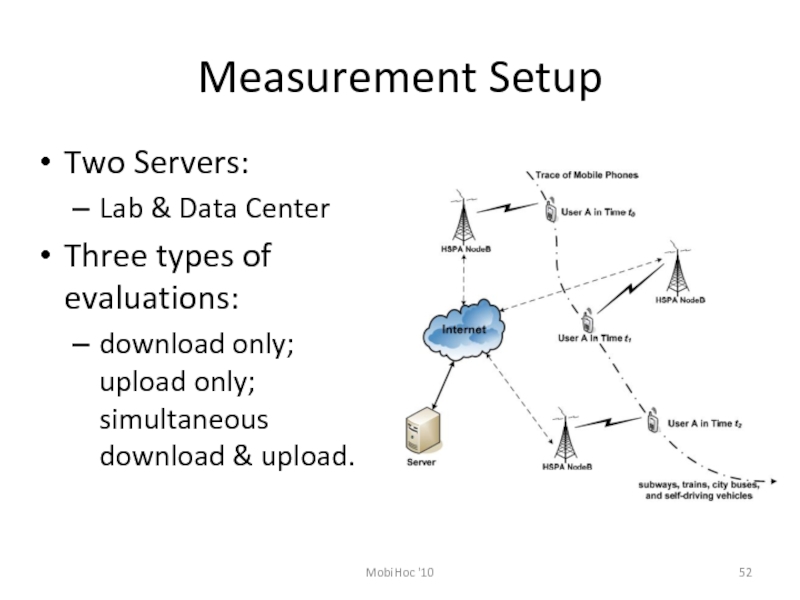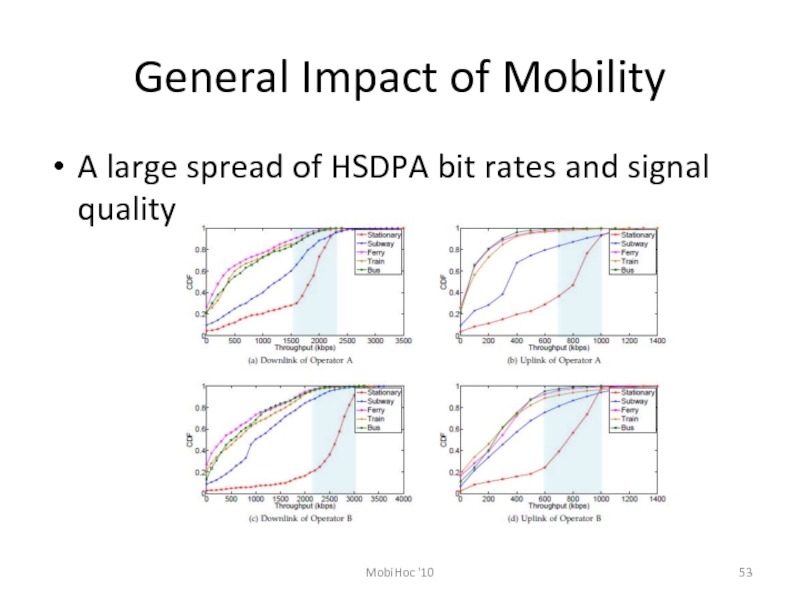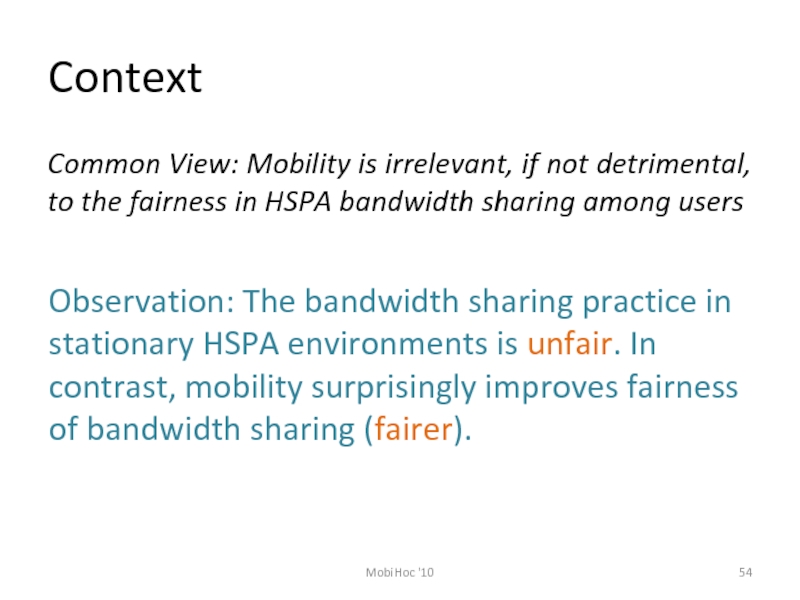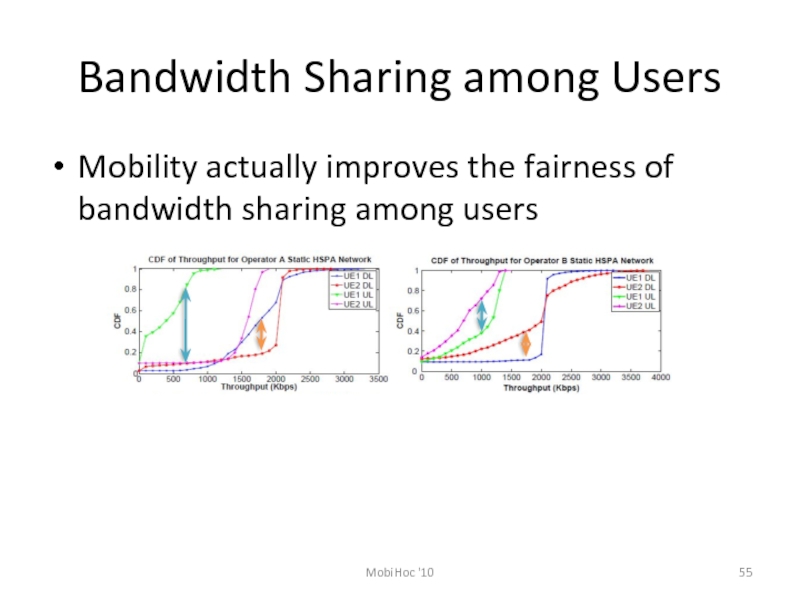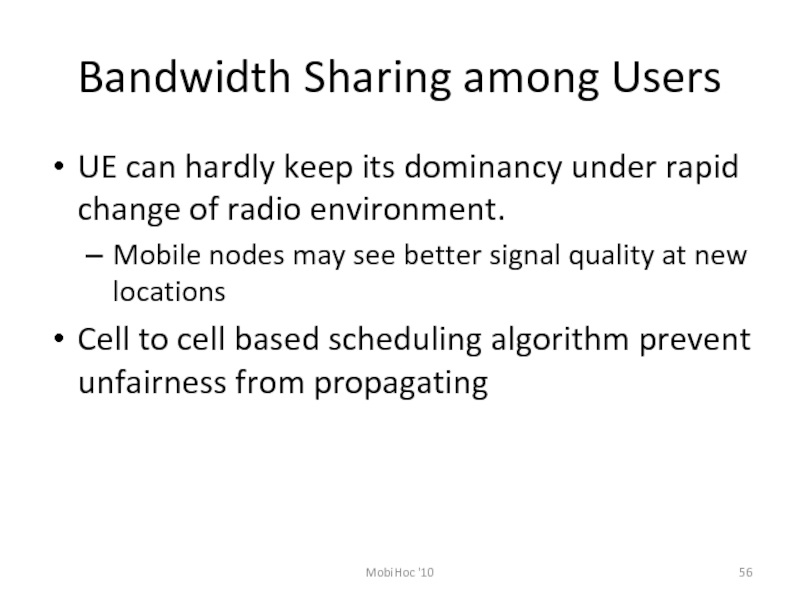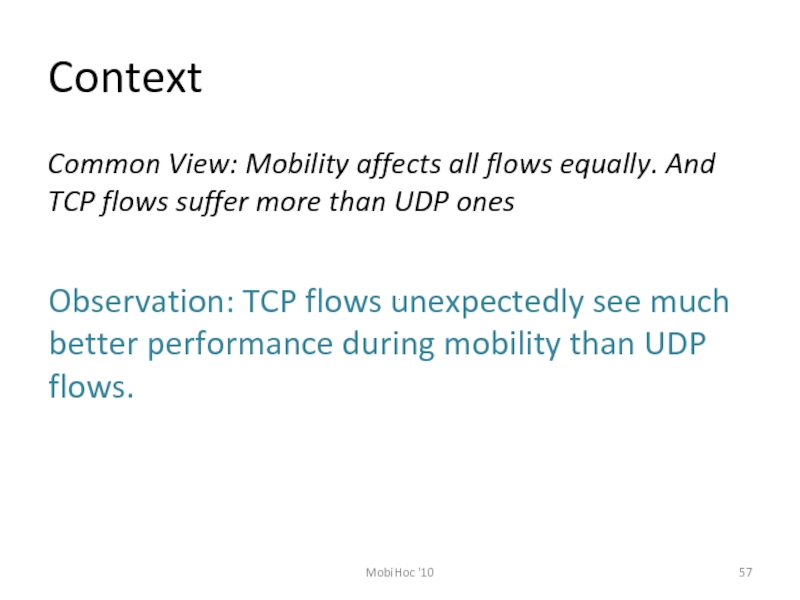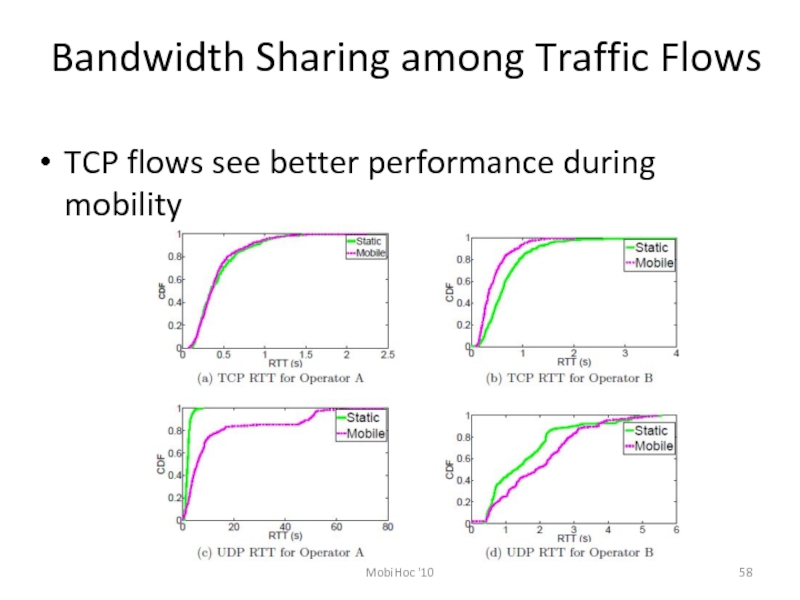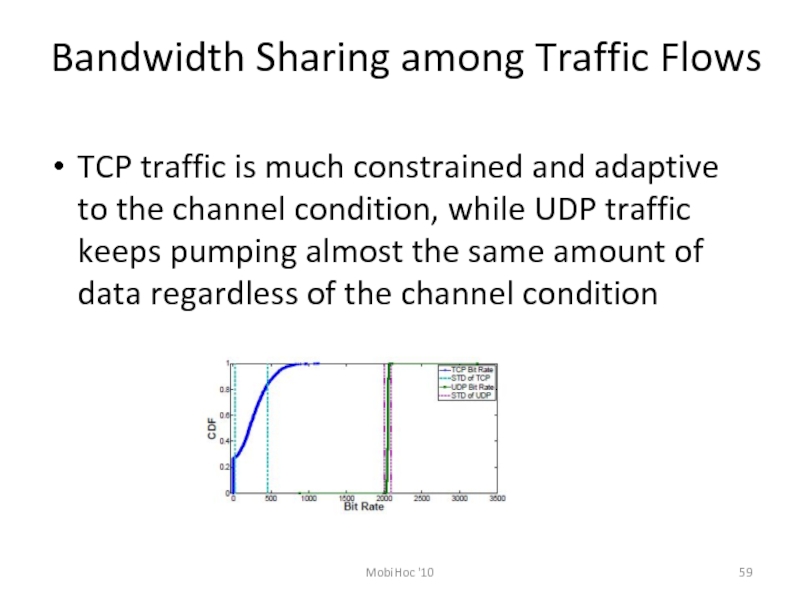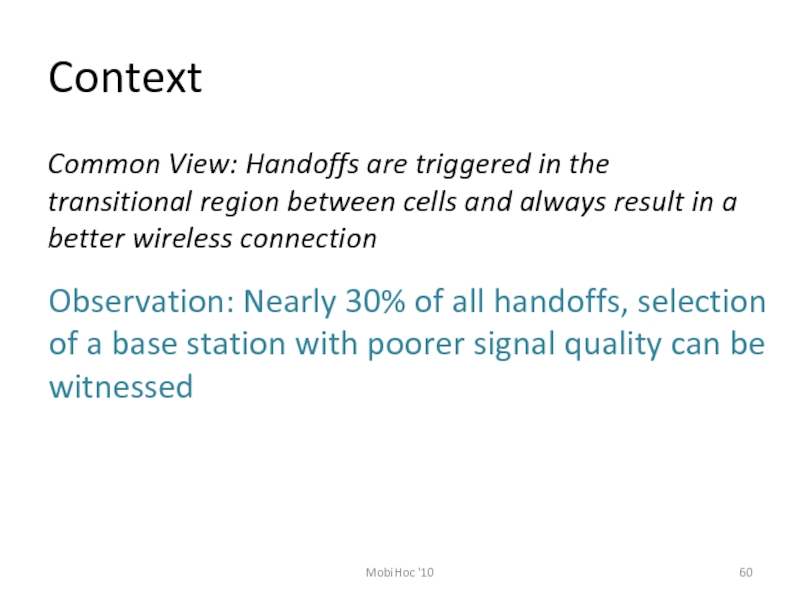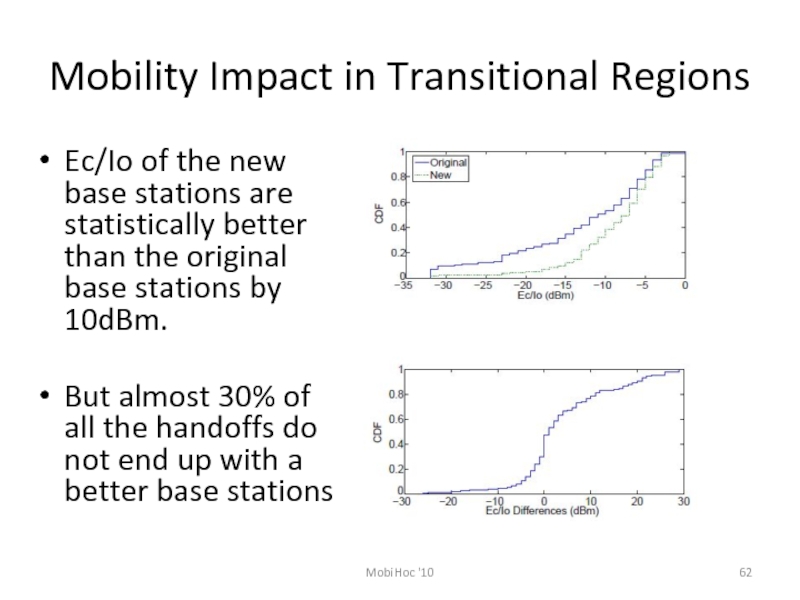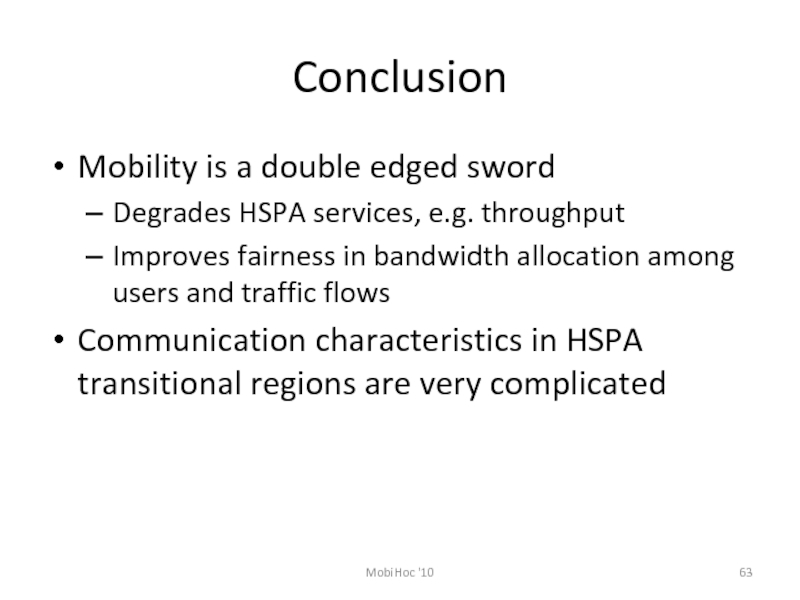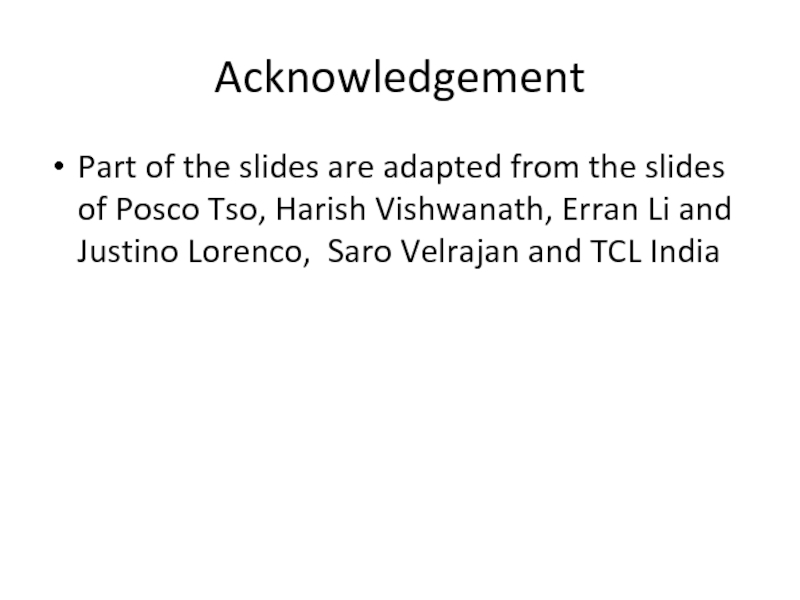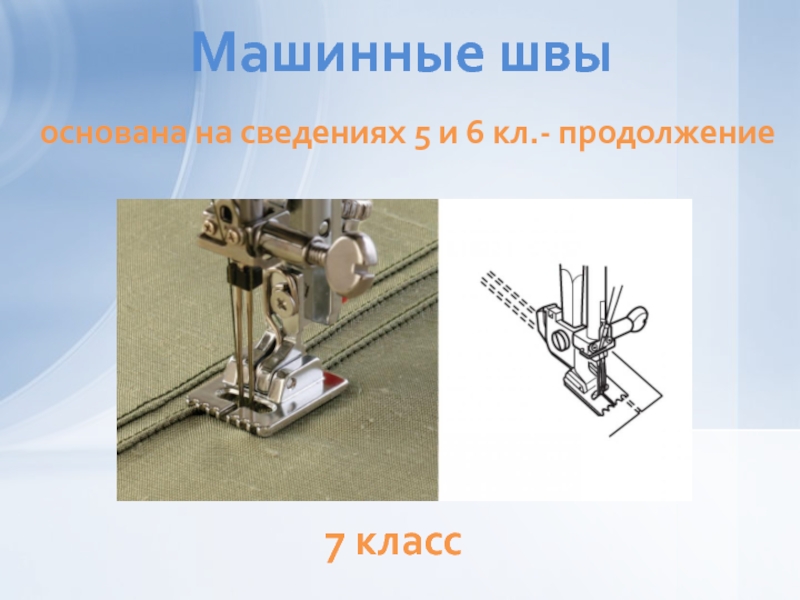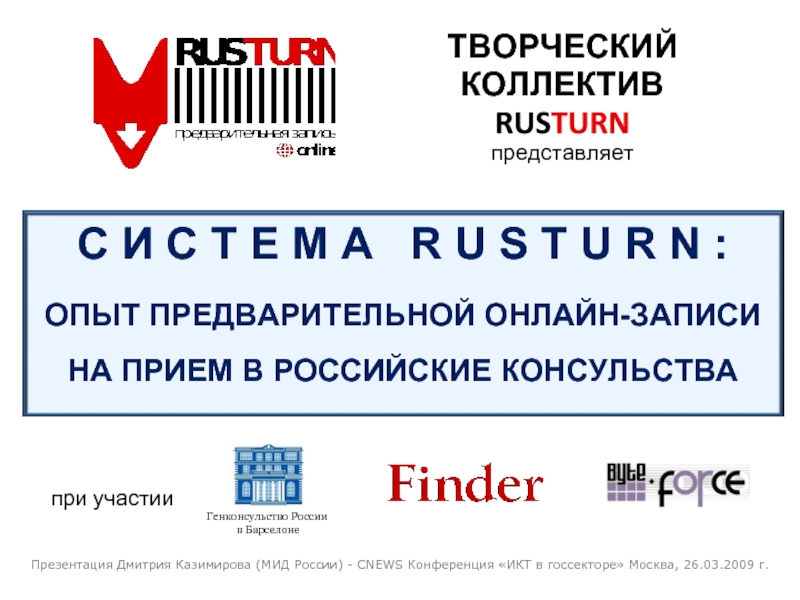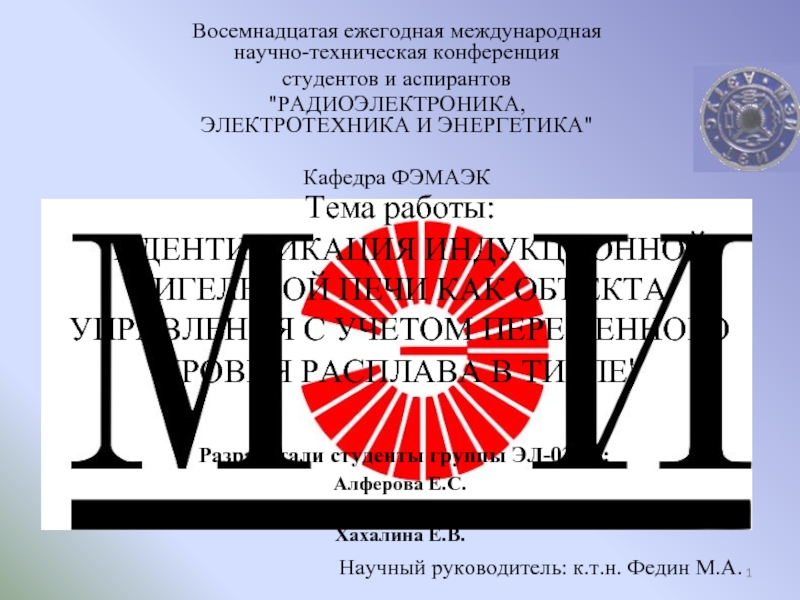- Главная
- Разное
- Дизайн
- Бизнес и предпринимательство
- Аналитика
- Образование
- Развлечения
- Красота и здоровье
- Финансы
- Государство
- Путешествия
- Спорт
- Недвижимость
- Армия
- Графика
- Культурология
- Еда и кулинария
- Лингвистика
- Английский язык
- Астрономия
- Алгебра
- Биология
- География
- Детские презентации
- Информатика
- История
- Литература
- Маркетинг
- Математика
- Медицина
- Менеджмент
- Музыка
- МХК
- Немецкий язык
- ОБЖ
- Обществознание
- Окружающий мир
- Педагогика
- Русский язык
- Технология
- Физика
- Философия
- Химия
- Шаблоны, картинки для презентаций
- Экология
- Экономика
- Юриспруденция
Мобильные сотовые сети презентация
Содержание
- 1. Мобильные сотовые сети
- 2. Основы сотовой связи There are many types
- 3. Сотовая связь Base stations transmit to and
- 4. Поколения сотовой связи It is useful to
- 5. Развитие сотовой связи 1G 2G 3G 4G 2.5G
- 6. Проблема Множественного Доступа Базовые станции должны обслуживать
- 7. Схемы Множественного Доступа Frequency Division Multiple
- 8. множественный доступ с разделением каналов по частоте
- 9. множественный доступ с разделением по времени Время
- 10. множественный доступ с кодовым разделением Использование ортогональных
- 11. 2G(GSM)
- 12. GSM Global System for Mobile Communications глобальный
- 13. GSM услуги Голосe, 3.1 kHz служба коротких
- 14. GSM Каналы Физический канал: каждый таймслот на
- 15. GSM Частоты Изначально рассчитаны на диапазон 900
- 16. GSM Архитектура
- 17. Mobile Station (MS) MS is the user’s
- 18. Subscriber Identity Module A small smart card
- 19. Base Station Subsystem подсистема базовых станций Transcoding
- 20. Network and Switching Subsystem подсистема сети и
- 21. Home Location Register домашний регистр местоположения One
- 22. Другие системы Operations Support System Система Поддержки
- 23. Смена Местоположения При перекрытии сот мобильная станция
- 24. Handoff (Handover) When a call is in
- 25. Roaming When a MS enters another operators
- 26. 3G, 3.5G and 4G (LTE)
- 27. 3G Обзор 3G is created by ITU-T and is called IMT-2000
- 28. Развитие от 2G
- 29. Service Roadmap Improved performance, decreasing cost of
- 30. GSM развитие к 3G
- 31. UMTS Universal Mobile Telecommunications System (UMTS) UMTS
- 32. UMTS Frequency Spectrum UMTS Band 1900-2025
- 33. UMTS Architecture
- 34. UMTS Network Architecture UMTS network architecture consists
- 35. UTRAN Wide band CDMA technology is selected
- 36. 3.5G (HSPA) High Speed Packet Access (HSPA)
- 37. 4G (LTE) LTE stands for Long Term
- 38. Advantages of LTE
- 39. Comparison of LTE Speed
- 40. Major LTE Radio Technogies Uses Orthogonal Frequency
- 41. LTE Architecture
- 42. LTE vs UMTS Functional changes compared to the current UMTS architecture
- 43. Case Study Mobility: A Double-Edged Sword
- 44. Context Evolved hardware technologies + Improved network bandwidth = Entertainment apps on mobile MobiHoc '10
- 45. Context MobiHoc '10 When you are NOT mobile, you use
- 46. Context MobiHoc '10 When you are mobile, you use
- 47. Context MobiHoc '10 Millions of passengers per day!
- 48. Context MobiHoc '10 Can HSPA provide the
- 49. Outline Measurement Methodology General Impact of Mobility
- 50. Measurement Routes MobiHoc '10
- 51. Measurement Route MobiHoc '10 Over 100 km in 3 months
- 52. Measurement Setup Two Servers: Lab & Data
- 53. General Impact of Mobility A large spread
- 54. Context MobiHoc '10 Common View: Mobility is
- 55. Bandwidth Sharing among Users Mobility actually improves
- 56. Bandwidth Sharing among Users UE can hardly
- 57. Context MobiHoc '10 Common View: Mobility affects
- 58. Bandwidth Sharing among Traffic Flows TCP flows see better performance during mobility MobiHoc '10
- 59. Bandwidth Sharing among Traffic Flows TCP traffic
- 60. Context MobiHoc '10 Common View: Handoffs are
- 61. Mobility Impact in Transitional Regions throughput often
- 62. Mobility Impact in Transitional Regions Ec/Io of
- 63. Conclusion Mobility is a double edged sword
- 64. Acknowledgement Part of the slides are adapted
Слайд 2Основы сотовой связи
There are many types of cellular services; before delving
Cellular network/telephony is a radio-based technology; radio waves are electromagnetic waves that antennas propagate
Most signals are in the 850 MHz, 900 MHz, 1800 MHz, and 1900 MHz frequency bands
Cell phones operate in this frequency range (note the logarithmic scale)
Слайд 3Сотовая связь
Base stations transmit to and receive from mobiles at the
Multiple base stations use the same spectrum (spectral reuse)
The service area of each base station is called a cell
Each mobile terminal is typically served by the ‘closest’ base stations
Handoff when terminals move
Слайд 4Поколения сотовой связи
It is useful to think of cellular Network/telephony in
0G: Briefcase-size mobile radio telephones
1G: Analog cellular telephony
2G: Digital cellular telephony
3G: High-speed digital cellular telephony (including video telephony)
4G: IP-based “anytime, anywhere” voice, data, and multimedia telephony at faster data rates than 3G (to be deployed in 2012–2015)
Слайд 6Проблема
Множественного Доступа
Базовые станции должны обслуживать множество мобильных терминалов одновременно (both downlink
Все мобильные телефоны в соте нужны для передачи к базовой станции
Интерференция между различными отправителями и получателями
Поэтому нужна схема множественного доступа
Слайд 7Схемы Множественного Доступа
Frequency Division Multiple Access (FDMA) множественный доступ с
Time Division Multiple Access (TDMA) множественный доступ с разделением по времени
Code Division Multiple Access (CDMA) множественный доступ с кодовым разделением
3 ортогональных схем :
Слайд 8множественный доступ с разделением каналов по частоте
Каждому мобильному назначается отдельный Частотный
Достаточная защитная полоса требуется для предотвращения интерференции от соседнего канала
Как правило, мобильные терминалы имеют одну нисходящую линию связи полосы частот и одну восходящую линию связи полосы частот
Разные сотовые сетевые протоколы используют разные частоты
frequency
Слайд 9множественный доступ с разделением по времени
Время делится на слоты и только
Каждому пользователю присваивается определенный слот. Нет конкуренции в сотовой сети В отличие от множественного доступа с прослушиванием несущей в WiFi
увеличенная продолжительность– сигнал передается на мобильные терминалы в разных местах не поступают на базовую станцию одновременно
Слайд 10множественный доступ с кодовым разделением
Использование ортогональных кодов для разделения разных трансмиссий
Каждый
-Ширина полосы частот, занятой сигналом, намного больше, чем скорость передачи информации
Но все Пользователи используют ту же полосу частот совместно
Ортогональность среди пользователей
Слайд 12GSM
Global System for Mobile Communications
глобальный цифровой стандарт для мобильной сотовой связи
Concurrent
The European system was called GSM and deployed in the early 1990’s
Слайд 13GSM услуги
Голосe, 3.1 kHz
служба коротких сообщений Short Message Service (SMS)
1985
Over 2.4 billion people use it; multi-billion $ industry
пакетная радиосвязь общего пользования General Packet Radio Service (GPRS)
GSM upgrade that provides IP-based packet data transmission up to 114 kbps
Users can “simultaneously” make calls and send data
GPRS provides “always on” Internet access and the Multimedia Messaging Service (MMS) whereby users can send rich text, audio, video messages to each other
Performance degrades as number of users increase
GPRS is an example of 2.5G telephony – 2G service similar to 3G
Слайд 14GSM Каналы
Физический канал: каждый таймслот на носителе называется физическим каналом
Логический канал:
-канал передачи трафика
- каналы управления
Downlink
Uplink
Каналы
Слайд 15GSM Частоты
Изначально рассчитаны на диапазон 900 МГц, сейчас также доступен на
Отдельного uplink и downlink частоты
Одним из примеров : частотный диапазон каналов 1800 МГц, где несущая радиочастота разделена каждые 200 МГц
1710 MHz
1880 MHz
1805 MHz
1785 MHz
UPLINK FREQUENCIES
DOWNLINK FREQUENCIES
UPLINK AND DOWNLINK FREQUENCY SEPARATED BY 95MHZ
Слайд 17Mobile Station (MS)
MS is the user’s handset and has two parts
Mobile
Radio equipment
User interface
Processing capability and memory required for various tasks
Call signalling
Encryption
SMS
Equipment IMEI number
Subscriber Identity Module
Слайд 18Subscriber Identity Module
A small smart card
Encryption codes needed to identify the
Subscriber IMSI number
Subscriber’s own information (telephone directory)
Third party applications (banking etc.)
Can also be used in other systems besides GSM, e.g., some WLAN access points accept SIM based user authentication
Слайд 19Base Station Subsystem
подсистема базовых станций
Transcoding Rate and Adaptation Unit (TRAU)
Выполняет кодирование
Base Station Controller (BSC)
Контролирует канал (тайм-слот) распределение осуществляемые BTS
Управляет хэндоверами в пределах BSS
Знает, какие мобильные станции в пределах ячейки и информирует MSC/VLR об этом
Base Transceiver System (BTS)
Controls several transmitters
Each transmitter has 8 time slots, some used for signaling, on a specific frequency
Слайд 20Network and Switching Subsystem
подсистема сети и коммутации
опорная сеть GSM -телефонная сеть
В типичной телефонной станции (сети ISDN Exchange), которая поддерживает мобильную связь
Visitor Location Register (VLR)
A database, part of the MSC
Contains the location of the active Mobile Stations
Gateway Mobile Switching Center (GMSC)
Links the system to PSTN and other operators
Home Location Register (HLR)
Contain subscriber information, including authentication information in Authentication Center (AuC)
Equipment Identity Register (EIR)
International Mobile Station Equipment Identity (IMEI) codes for e.g., blacklisting stolen phones
Слайд 21Home Location Register
домашний регистр местоположения
One database per operator
Contains all the permanent
MSISDN (Mobile Subscriber ISDN number) is the telephone number of the subscriber
International Mobile Subscriber Identity (IMSI) is a 15 digit code used to identify the subscriber
It incorporates a country code and operator code
IMSI code is used to link the MSISDN number to the subscriber’s SIM (Subscriber Identity Module)
Charging information
Services available to the customer
Also the subscriber’s present Location Area Code, which refers to the MSC, which can connect to the MS.
Слайд 22Другие системы
Operations Support System Система Поддержки Операций
The management network for the
Usually vendor dependent
Very loosely specified in the GSM standards
Услуги с добавленной стоимостью
-Voice mail
Call forwarding
Group calls
Short Message Service Center Центр
Службы Коротких Сообщений
-Stores and forwards the SMS messages
Like an E-mail server
Required to operate the SMS services
Слайд 23Смена Местоположения
При перекрытии сот мобильная станция может "видеть" несколько приемопередатчиков (BTSes)
МС
Когда мобильная станция приближается в область новойBSC, она просит обновления местоположения
Обновления передаются на MSC, заносится в VLR, старая BSC уведомлена и подтверждение передается обратно
Слайд 24Handoff (Handover)
When a call is in process, the changes in location
Within a BSS, the BSC, which knows the current radio link configuration (including feedbacks from the MS), prepares an available channel in the new BTS
The MS is told to switch over to the new BTS
This is called a hard handoff
In a soft handoff, the MS is connected to two BTSes simultaneously
Слайд 25Roaming
When a MS enters another operators network, it can be allowed
Operator to operator agreements and contracts
Higher billing
The MS is identified by the information in the SIM card and the identification request is forwarded to the home operator
The home HLR is updated to reflect the MS’s current location
Слайд 29Service Roadmap
Improved performance, decreasing cost of delivery
Typical average bit rates
(peak
WEB browsing
Corporate data access
Streaming audio/video
Voice & SMS
Presence/location
xHTML browsing
Application downloading
E-mail
MMS picture / video
Multitasking
3G-specific services take advantage of higher bandwidth and/or real-time QoS
A number of mobile services are bearer independent in nature
Broadband
in wide area
Video sharing
Video telephony
Real-time IP
multimedia and games
Multicasting
Слайд 31UMTS
Universal Mobile Telecommunications System (UMTS)
UMTS is an upgrade from GSM via
The standardization work for UMTS is carried out by Third Generation Partnership Project (3GPP)
Data rates of UMTS are:
144 kbps for rural
384 kbps for urban outdoor
2048 kbps for indoor and low range outdoor
Virtual Home Environment (VHE)
Слайд 32UMTS Frequency Spectrum
UMTS Band
1900-2025 MHz and 2110-2200 MHz for 3G
In the US, 1710–1755 MHz and 2110–2155 MHz will be used instead, as the 1900 MHz band was already used.
Слайд 34UMTS Network Architecture
UMTS network architecture consists of three domains
Core Network (CN):
UMTS Terrestrial Radio Access Network (UTRAN): Provides the air interface access method for user equipment.
User Equipment (UE): Terminals work as air interface counterpart for base stations. The various identities are: IMSI, TMSI, P-TMSI, TLLI, MSISDN, IMEI, IMEISV
Слайд 35UTRAN
Wide band CDMA technology is selected for UTRAN air interface
WCDMA
TD-SCDMA
Base stations
Functions of Node-B are
Air Interface Tx/Rx
Modulation/Demodulation
Functions of RNC are:
Radio Resource Control
Channel Allocation
Power Control Settings
Handover Control
Ciphering
Segmentation and reassembly
Слайд 363.5G (HSPA)
High Speed Packet Access (HSPA) is an amalgamation of two
3.5G introduces many new features that will enhance the UMTS technology in future. 1xEV-DV already supports most of the features that will be provided in 3.5G. These include:
- Adaptive Modulation and Coding
- Fast Scheduling
- Backward compatibility with 3G
- Enhanced Air Interface
Слайд 374G (LTE)
LTE stands for Long Term Evolution
Next Generation mobile broadband technology
Promises
Based on UMTS 3G technology
Optimized for All-IP traffic
Слайд 40Major LTE Radio Technogies
Uses Orthogonal Frequency Division Multiplexing (OFDM) for downlink
Uses
Uses Multi-input Multi-output(MIMO) for enhanced throughput
Reduced power consumption
Higher RF power amplifier efficiency (less battery power used by handsets)
Слайд 43Case Study
Mobility:
A Double-Edged Sword
for HSPA Networks
Fung Po Tso, City
Jin Teng, Ohio State University
Weijia Jia, City University of Hong Kong
Dong Xuan, Ohio State University
ACM Mobihoc’10
Слайд 44Context
Evolved hardware technologies
+
Improved network bandwidth
=
Entertainment apps on mobile
MobiHoc '10
Слайд 48Context
MobiHoc '10
Can HSPA provide the same level of service to mobile
pictures’ source: Wikipedia
Слайд 49Outline
Measurement Methodology
General Impact of Mobility
Mobility Impact on Bandwidth Sharing
Mobility Impact in
Conclusion
MobiHoc '10
Слайд 52Measurement Setup
Two Servers:
Lab & Data Center
Three types of evaluations:
download only;
MobiHoc '10
Слайд 54Context
MobiHoc '10
Common View: Mobility is irrelevant, if not detrimental, to the
Observation: The bandwidth sharing practice in stationary HSPA environments is unfair. In contrast, mobility surprisingly improves fairness of bandwidth sharing (fairer).
Слайд 55Bandwidth Sharing among Users
Mobility actually improves the fairness of bandwidth sharing
MobiHoc '10
Слайд 56Bandwidth Sharing among Users
UE can hardly keep its dominancy under rapid
Mobile nodes may see better signal quality at new locations
Cell to cell based scheduling algorithm prevent unfairness from propagating
MobiHoc '10
Слайд 57Context
MobiHoc '10
Common View: Mobility affects all flows equally. And TCP flows
Observation: TCP flows unexpectedly see much better performance during mobility than UDP flows.
Слайд 58Bandwidth Sharing among Traffic Flows
TCP flows see better performance during mobility
MobiHoc
Слайд 59Bandwidth Sharing among Traffic Flows
TCP traffic is much constrained and adaptive
MobiHoc '10
Слайд 60Context
MobiHoc '10
Common View: Handoffs are triggered in the transitional region between
Observation: Nearly 30% of all handoffs, selection of a base station with poorer signal quality can be witnessed
Слайд 61Mobility Impact in Transitional Regions
throughput often drops sharply, and sometimes, as
MobiHoc '10
Слайд 62Mobility Impact in Transitional Regions
Ec/Io of the new base stations are
But almost 30% of all the handoffs do not end up with a better base stations
MobiHoc '10
Слайд 63Conclusion
Mobility is a double edged sword
Degrades HSPA services, e.g. throughput
Improves fairness
Communication characteristics in HSPA transitional regions are very complicated
MobiHoc '10

